Impact of PASI Pension Rate and Other Factors on SMEs in Oman
VerifiedAdded on 2023/06/03
|29
|8409
|458
AI Summary
This study analyzes the impact of Public Authority for Social Insurances’ (PASI) Pension Rate and other factors on the overall success and growth of SMEs in the Sultanate of Oman. It also evaluates the role of Social Insurance law on the SMEs growth and the challenges faced by SMEs to fulfill the pension rate set by PASI.
Contribute Materials
Your contribution can guide someone’s learning journey. Share your
documents today.
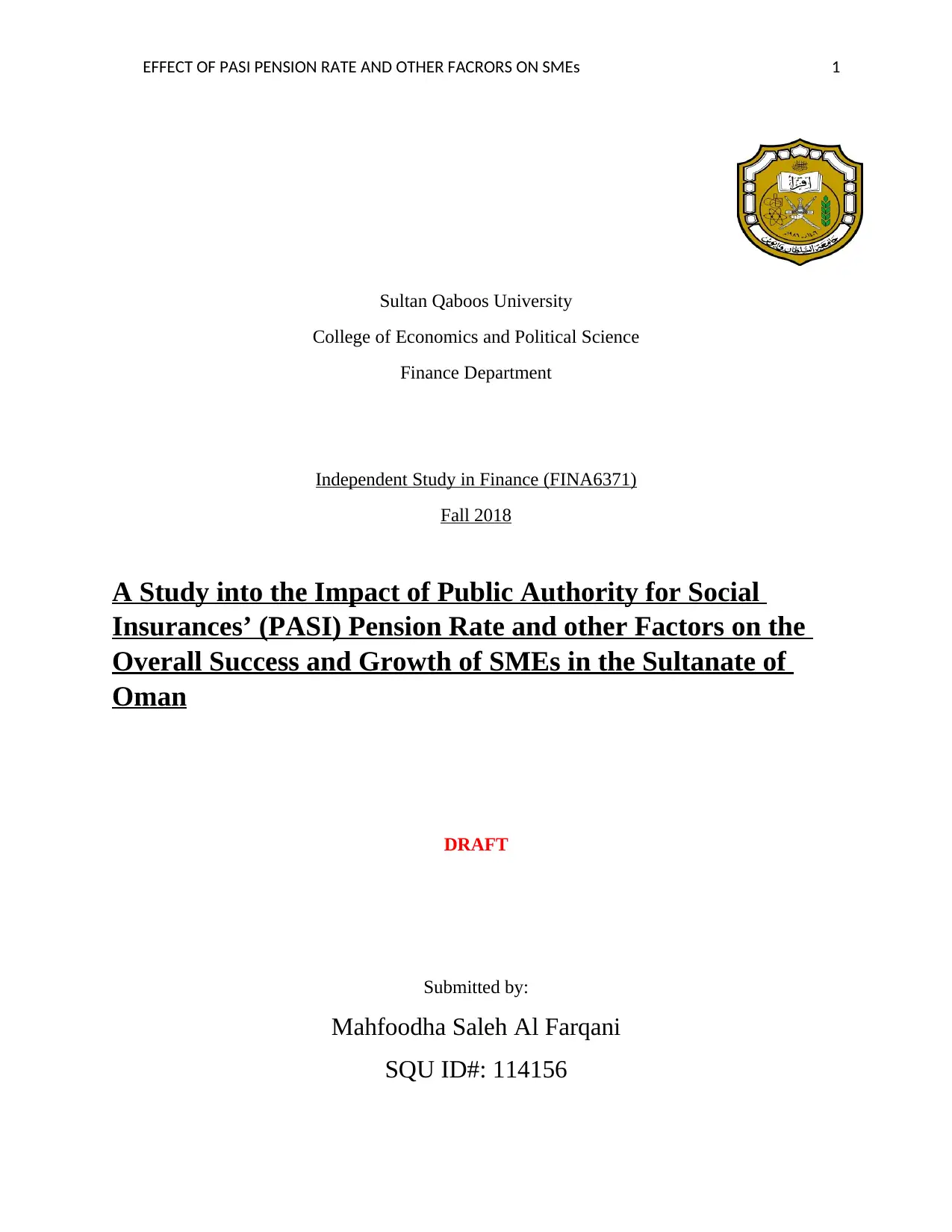
EFFECT OF PASI PENSION RATE AND OTHER FACRORS ON SMEs 1
Sultan Qaboos University
College of Economics and Political Science
Finance Department
Independent Study in Finance (FINA6371)
Fall 2018
A Study into the Impact of Public Authority for Social
Insurances’ (PASI) Pension Rate and other Factors on the
Overall Success and Growth of SMEs in the Sultanate of
Oman
DRAFT
Submitted by:
Mahfoodha Saleh Al Farqani
SQU ID#: 114156
Sultan Qaboos University
College of Economics and Political Science
Finance Department
Independent Study in Finance (FINA6371)
Fall 2018
A Study into the Impact of Public Authority for Social
Insurances’ (PASI) Pension Rate and other Factors on the
Overall Success and Growth of SMEs in the Sultanate of
Oman
DRAFT
Submitted by:
Mahfoodha Saleh Al Farqani
SQU ID#: 114156
Secure Best Marks with AI Grader
Need help grading? Try our AI Grader for instant feedback on your assignments.
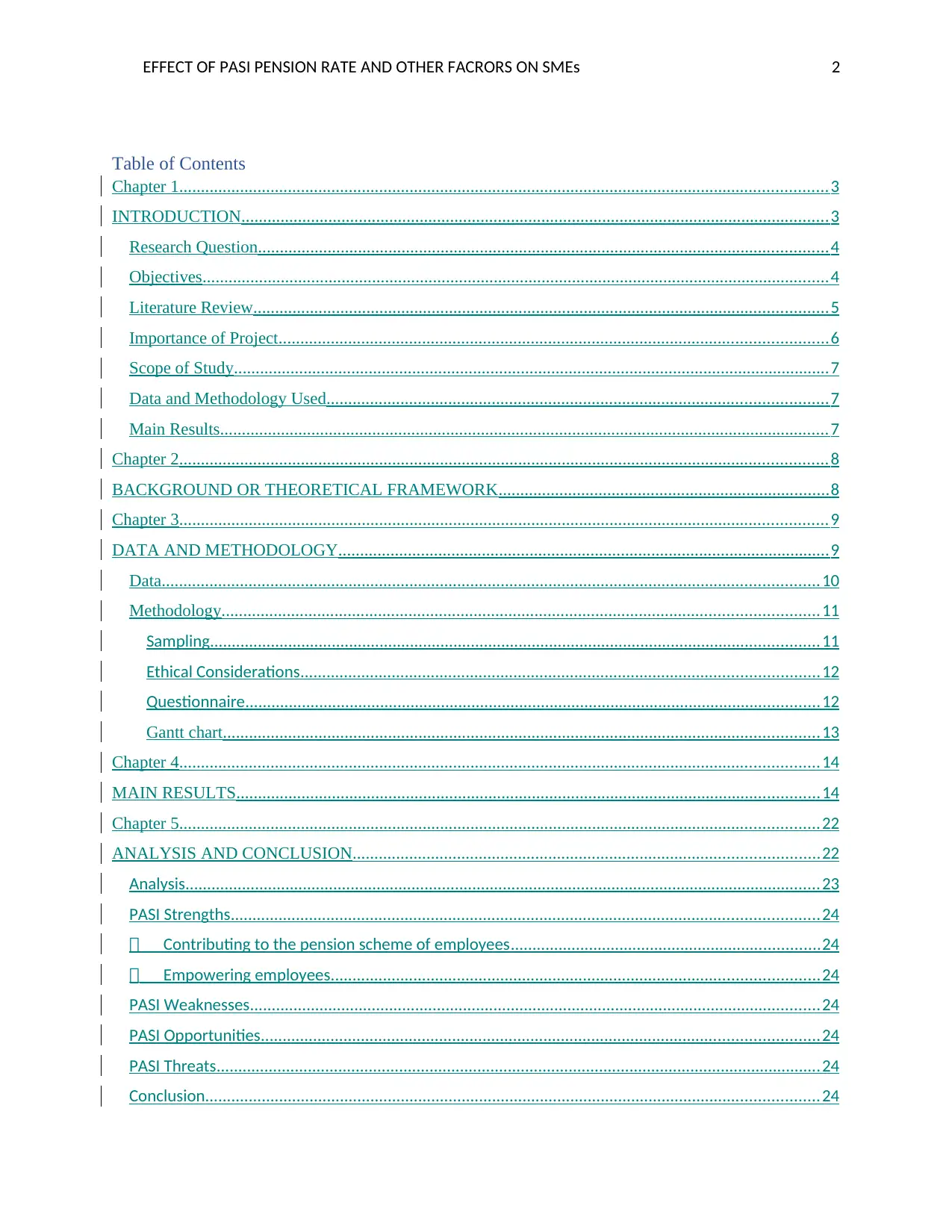
EFFECT OF PASI PENSION RATE AND OTHER FACRORS ON SMEs 2
Table of Contents
Chapter 1.....................................................................................................................................................3
INTRODUCTION.......................................................................................................................................3
Research Question...................................................................................................................................4
Objectives................................................................................................................................................4
Literature Review....................................................................................................................................5
Importance of Project..............................................................................................................................6
Scope of Study.........................................................................................................................................7
Data and Methodology Used...................................................................................................................7
Main Results............................................................................................................................................7
Chapter 2.....................................................................................................................................................8
BACKGROUND OR THEORETICAL FRAMEWORK............................................................................8
Chapter 3.....................................................................................................................................................9
DATA AND METHODOLOGY.................................................................................................................9
Data.......................................................................................................................................................10
Methodology.........................................................................................................................................11
Sampling............................................................................................................................................11
Ethical Considerations.......................................................................................................................12
Questionnaire....................................................................................................................................12
Gantt chart.........................................................................................................................................13
Chapter 4...................................................................................................................................................14
MAIN RESULTS......................................................................................................................................14
Chapter 5...................................................................................................................................................22
ANALYSIS AND CONCLUSION...........................................................................................................22
Analysis..................................................................................................................................................23
PASI Strengths.......................................................................................................................................24
Contributing to the pension scheme of employees.......................................................................24
Empowering employees................................................................................................................24
PASI Weaknesses...................................................................................................................................24
PASI Opportunities................................................................................................................................24
PASI Threats...........................................................................................................................................24
Conclusion.............................................................................................................................................24
Table of Contents
Chapter 1.....................................................................................................................................................3
INTRODUCTION.......................................................................................................................................3
Research Question...................................................................................................................................4
Objectives................................................................................................................................................4
Literature Review....................................................................................................................................5
Importance of Project..............................................................................................................................6
Scope of Study.........................................................................................................................................7
Data and Methodology Used...................................................................................................................7
Main Results............................................................................................................................................7
Chapter 2.....................................................................................................................................................8
BACKGROUND OR THEORETICAL FRAMEWORK............................................................................8
Chapter 3.....................................................................................................................................................9
DATA AND METHODOLOGY.................................................................................................................9
Data.......................................................................................................................................................10
Methodology.........................................................................................................................................11
Sampling............................................................................................................................................11
Ethical Considerations.......................................................................................................................12
Questionnaire....................................................................................................................................12
Gantt chart.........................................................................................................................................13
Chapter 4...................................................................................................................................................14
MAIN RESULTS......................................................................................................................................14
Chapter 5...................................................................................................................................................22
ANALYSIS AND CONCLUSION...........................................................................................................22
Analysis..................................................................................................................................................23
PASI Strengths.......................................................................................................................................24
Contributing to the pension scheme of employees.......................................................................24
Empowering employees................................................................................................................24
PASI Weaknesses...................................................................................................................................24
PASI Opportunities................................................................................................................................24
PASI Threats...........................................................................................................................................24
Conclusion.............................................................................................................................................24
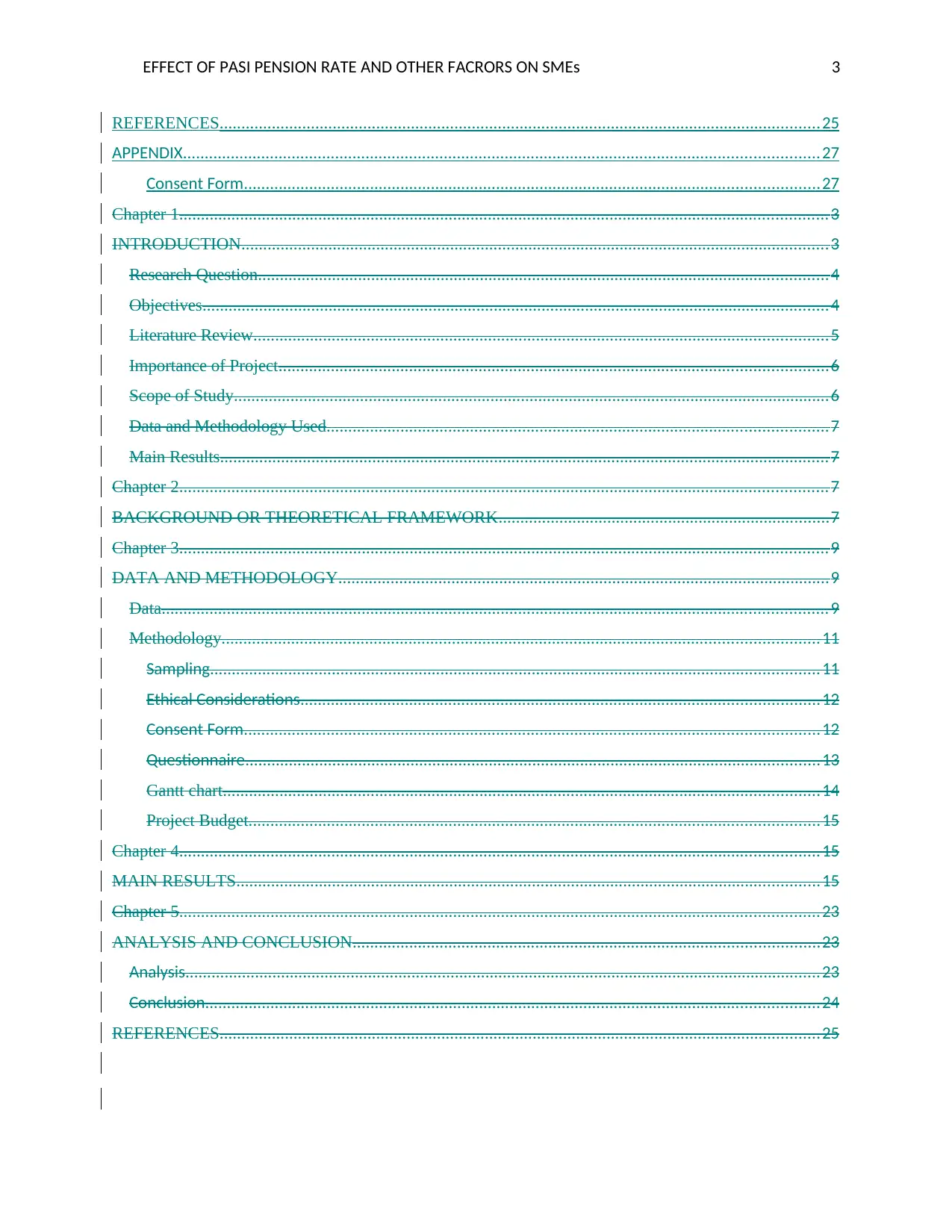
EFFECT OF PASI PENSION RATE AND OTHER FACRORS ON SMEs 3
REFERENCES..........................................................................................................................................25
APPENDIX..................................................................................................................................................27
Consent Form....................................................................................................................................27
Chapter 1.....................................................................................................................................................3
INTRODUCTION.......................................................................................................................................3
Research Question...................................................................................................................................4
Objectives................................................................................................................................................4
Literature Review....................................................................................................................................5
Importance of Project..............................................................................................................................6
Scope of Study.........................................................................................................................................6
Data and Methodology Used...................................................................................................................7
Main Results............................................................................................................................................7
Chapter 2.....................................................................................................................................................7
BACKGROUND OR THEORETICAL FRAMEWORK............................................................................7
Chapter 3.....................................................................................................................................................9
DATA AND METHODOLOGY.................................................................................................................9
Data.........................................................................................................................................................9
Methodology.........................................................................................................................................11
Sampling............................................................................................................................................11
Ethical Considerations.......................................................................................................................12
Consent Form....................................................................................................................................12
Questionnaire....................................................................................................................................13
Gantt chart.........................................................................................................................................14
Project Budget...................................................................................................................................15
Chapter 4...................................................................................................................................................15
MAIN RESULTS......................................................................................................................................15
Chapter 5...................................................................................................................................................23
ANALYSIS AND CONCLUSION...........................................................................................................23
Analysis..................................................................................................................................................23
Conclusion.............................................................................................................................................24
REFERENCES..........................................................................................................................................25
REFERENCES..........................................................................................................................................25
APPENDIX..................................................................................................................................................27
Consent Form....................................................................................................................................27
Chapter 1.....................................................................................................................................................3
INTRODUCTION.......................................................................................................................................3
Research Question...................................................................................................................................4
Objectives................................................................................................................................................4
Literature Review....................................................................................................................................5
Importance of Project..............................................................................................................................6
Scope of Study.........................................................................................................................................6
Data and Methodology Used...................................................................................................................7
Main Results............................................................................................................................................7
Chapter 2.....................................................................................................................................................7
BACKGROUND OR THEORETICAL FRAMEWORK............................................................................7
Chapter 3.....................................................................................................................................................9
DATA AND METHODOLOGY.................................................................................................................9
Data.........................................................................................................................................................9
Methodology.........................................................................................................................................11
Sampling............................................................................................................................................11
Ethical Considerations.......................................................................................................................12
Consent Form....................................................................................................................................12
Questionnaire....................................................................................................................................13
Gantt chart.........................................................................................................................................14
Project Budget...................................................................................................................................15
Chapter 4...................................................................................................................................................15
MAIN RESULTS......................................................................................................................................15
Chapter 5...................................................................................................................................................23
ANALYSIS AND CONCLUSION...........................................................................................................23
Analysis..................................................................................................................................................23
Conclusion.............................................................................................................................................24
REFERENCES..........................................................................................................................................25
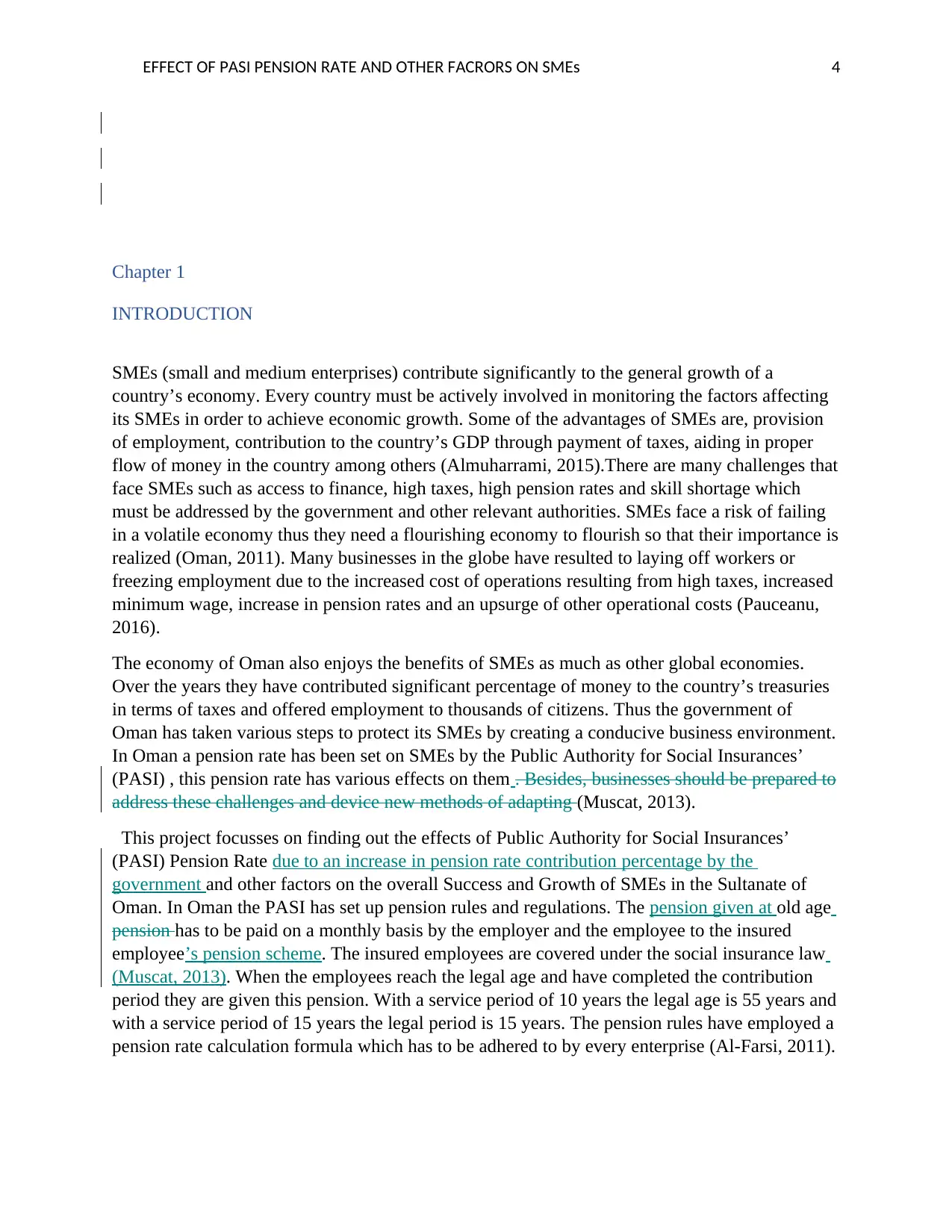
EFFECT OF PASI PENSION RATE AND OTHER FACRORS ON SMEs 4
Chapter 1
INTRODUCTION
SMEs (small and medium enterprises) contribute significantly to the general growth of a
country’s economy. Every country must be actively involved in monitoring the factors affecting
its SMEs in order to achieve economic growth. Some of the advantages of SMEs are, provision
of employment, contribution to the country’s GDP through payment of taxes, aiding in proper
flow of money in the country among others (Almuharrami, 2015).There are many challenges that
face SMEs such as access to finance, high taxes, high pension rates and skill shortage which
must be addressed by the government and other relevant authorities. SMEs face a risk of failing
in a volatile economy thus they need a flourishing economy to flourish so that their importance is
realized (Oman, 2011). Many businesses in the globe have resulted to laying off workers or
freezing employment due to the increased cost of operations resulting from high taxes, increased
minimum wage, increase in pension rates and an upsurge of other operational costs (Pauceanu,
2016).
The economy of Oman also enjoys the benefits of SMEs as much as other global economies.
Over the years they have contributed significant percentage of money to the country’s treasuries
in terms of taxes and offered employment to thousands of citizens. Thus the government of
Oman has taken various steps to protect its SMEs by creating a conducive business environment.
In Oman a pension rate has been set on SMEs by the Public Authority for Social Insurances’
(PASI) , this pension rate has various effects on them . Besides, businesses should be prepared to
address these challenges and device new methods of adapting (Muscat, 2013).
This project focusses on finding out the effects of Public Authority for Social Insurances’
(PASI) Pension Rate due to an increase in pension rate contribution percentage by the
government and other factors on the overall Success and Growth of SMEs in the Sultanate of
Oman. In Oman the PASI has set up pension rules and regulations. The pension given at old age
pension has to be paid on a monthly basis by the employer and the employee to the insured
employee’s pension scheme. The insured employees are covered under the social insurance law
(Muscat, 2013). When the employees reach the legal age and have completed the contribution
period they are given this pension. With a service period of 10 years the legal age is 55 years and
with a service period of 15 years the legal period is 15 years. The pension rules have employed a
pension rate calculation formula which has to be adhered to by every enterprise (Al-Farsi, 2011).
Chapter 1
INTRODUCTION
SMEs (small and medium enterprises) contribute significantly to the general growth of a
country’s economy. Every country must be actively involved in monitoring the factors affecting
its SMEs in order to achieve economic growth. Some of the advantages of SMEs are, provision
of employment, contribution to the country’s GDP through payment of taxes, aiding in proper
flow of money in the country among others (Almuharrami, 2015).There are many challenges that
face SMEs such as access to finance, high taxes, high pension rates and skill shortage which
must be addressed by the government and other relevant authorities. SMEs face a risk of failing
in a volatile economy thus they need a flourishing economy to flourish so that their importance is
realized (Oman, 2011). Many businesses in the globe have resulted to laying off workers or
freezing employment due to the increased cost of operations resulting from high taxes, increased
minimum wage, increase in pension rates and an upsurge of other operational costs (Pauceanu,
2016).
The economy of Oman also enjoys the benefits of SMEs as much as other global economies.
Over the years they have contributed significant percentage of money to the country’s treasuries
in terms of taxes and offered employment to thousands of citizens. Thus the government of
Oman has taken various steps to protect its SMEs by creating a conducive business environment.
In Oman a pension rate has been set on SMEs by the Public Authority for Social Insurances’
(PASI) , this pension rate has various effects on them . Besides, businesses should be prepared to
address these challenges and device new methods of adapting (Muscat, 2013).
This project focusses on finding out the effects of Public Authority for Social Insurances’
(PASI) Pension Rate due to an increase in pension rate contribution percentage by the
government and other factors on the overall Success and Growth of SMEs in the Sultanate of
Oman. In Oman the PASI has set up pension rules and regulations. The pension given at old age
pension has to be paid on a monthly basis by the employer and the employee to the insured
employee’s pension scheme. The insured employees are covered under the social insurance law
(Muscat, 2013). When the employees reach the legal age and have completed the contribution
period they are given this pension. With a service period of 10 years the legal age is 55 years and
with a service period of 15 years the legal period is 15 years. The pension rules have employed a
pension rate calculation formula which has to be adhered to by every enterprise (Al-Farsi, 2011).
Secure Best Marks with AI Grader
Need help grading? Try our AI Grader for instant feedback on your assignments.
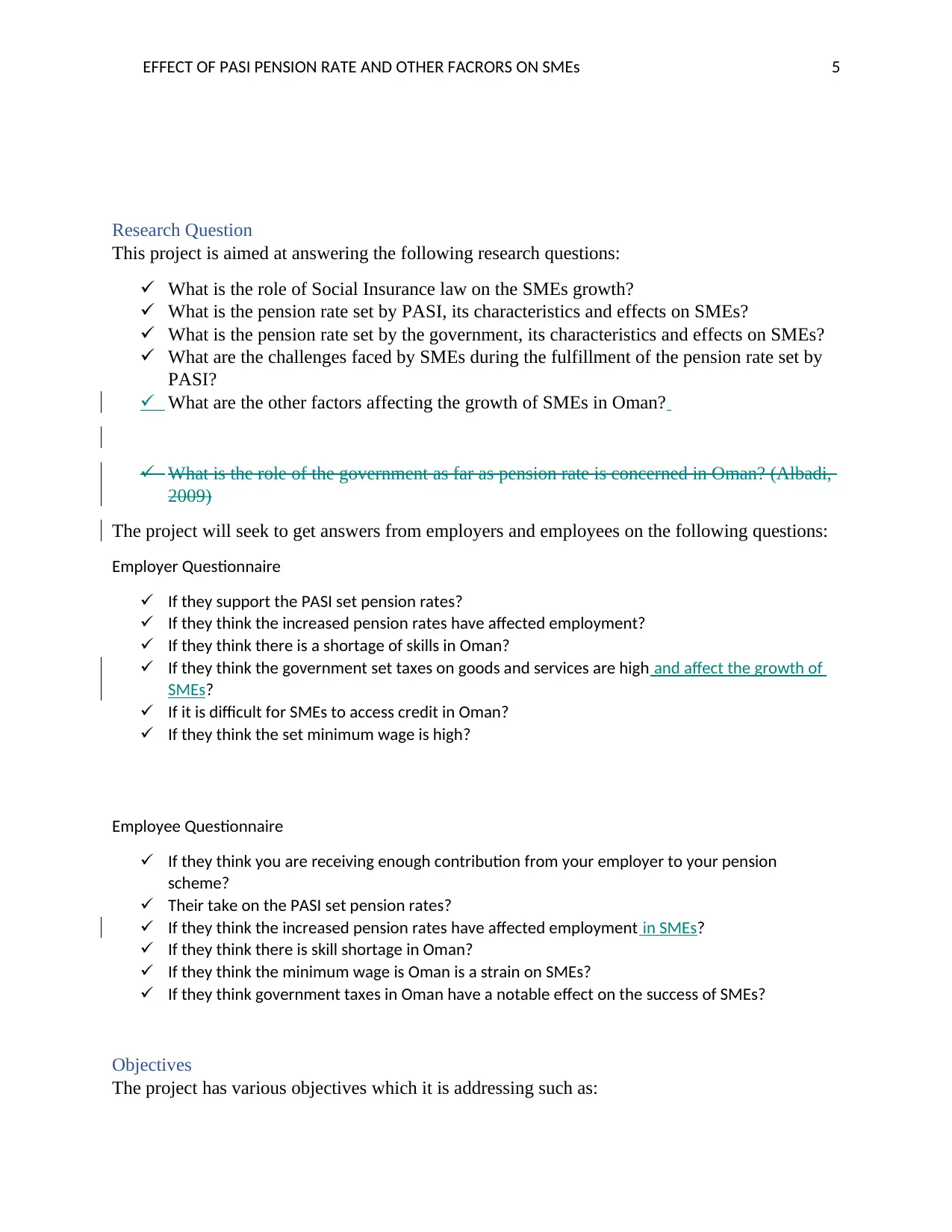
EFFECT OF PASI PENSION RATE AND OTHER FACRORS ON SMEs 5
Research Question
This project is aimed at answering the following research questions:
What is the role of Social Insurance law on the SMEs growth?
What is the pension rate set by PASI, its characteristics and effects on SMEs?
What is the pension rate set by the government, its characteristics and effects on SMEs?
What are the challenges faced by SMEs during the fulfillment of the pension rate set by
PASI?
What are the other factors affecting the growth of SMEs in Oman?
What is the role of the government as far as pension rate is concerned in Oman? (Albadi,
2009)
The project will seek to get answers from employers and employees on the following questions:
Employer Questionnaire
If they support the PASI set pension rates?
If they think the increased pension rates have affected employment?
If they think there is a shortage of skills in Oman?
If they think the government set taxes on goods and services are high and affect the growth of
SMEs?
If it is difficult for SMEs to access credit in Oman?
If they think the set minimum wage is high?
Employee Questionnaire
If they think you are receiving enough contribution from your employer to your pension
scheme?
Their take on the PASI set pension rates?
If they think the increased pension rates have affected employment in SMEs?
If they think there is skill shortage in Oman?
If they think the minimum wage is Oman is a strain on SMEs?
If they think government taxes in Oman have a notable effect on the success of SMEs?
Objectives
The project has various objectives which it is addressing such as:
Research Question
This project is aimed at answering the following research questions:
What is the role of Social Insurance law on the SMEs growth?
What is the pension rate set by PASI, its characteristics and effects on SMEs?
What is the pension rate set by the government, its characteristics and effects on SMEs?
What are the challenges faced by SMEs during the fulfillment of the pension rate set by
PASI?
What are the other factors affecting the growth of SMEs in Oman?
What is the role of the government as far as pension rate is concerned in Oman? (Albadi,
2009)
The project will seek to get answers from employers and employees on the following questions:
Employer Questionnaire
If they support the PASI set pension rates?
If they think the increased pension rates have affected employment?
If they think there is a shortage of skills in Oman?
If they think the government set taxes on goods and services are high and affect the growth of
SMEs?
If it is difficult for SMEs to access credit in Oman?
If they think the set minimum wage is high?
Employee Questionnaire
If they think you are receiving enough contribution from your employer to your pension
scheme?
Their take on the PASI set pension rates?
If they think the increased pension rates have affected employment in SMEs?
If they think there is skill shortage in Oman?
If they think the minimum wage is Oman is a strain on SMEs?
If they think government taxes in Oman have a notable effect on the success of SMEs?
Objectives
The project has various objectives which it is addressing such as:
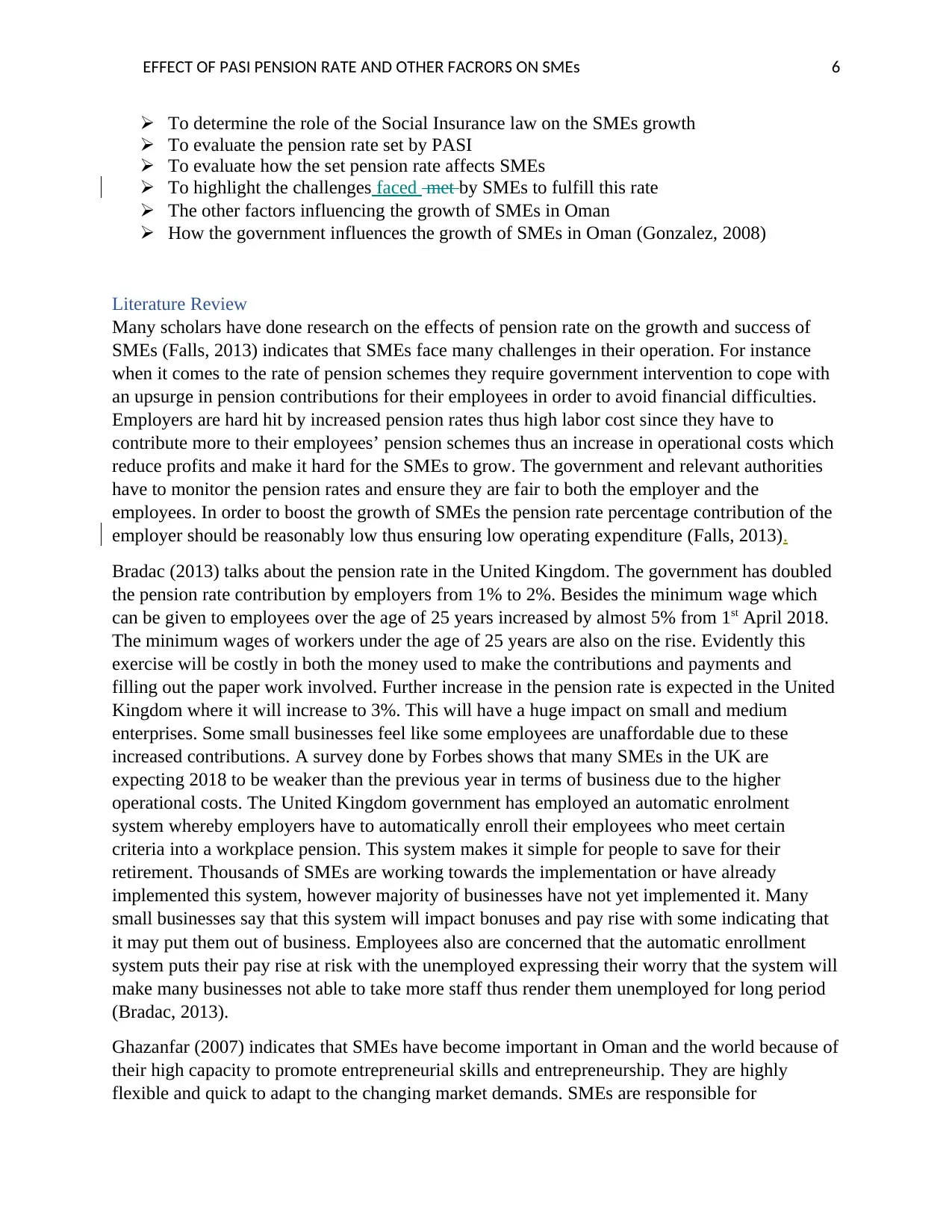
EFFECT OF PASI PENSION RATE AND OTHER FACRORS ON SMEs 6
To determine the role of the Social Insurance law on the SMEs growth
To evaluate the pension rate set by PASI
To evaluate how the set pension rate affects SMEs
To highlight the challenges faced met by SMEs to fulfill this rate
The other factors influencing the growth of SMEs in Oman
How the government influences the growth of SMEs in Oman (Gonzalez, 2008)
Literature Review
Many scholars have done research on the effects of pension rate on the growth and success of
SMEs (Falls, 2013) indicates that SMEs face many challenges in their operation. For instance
when it comes to the rate of pension schemes they require government intervention to cope with
an upsurge in pension contributions for their employees in order to avoid financial difficulties.
Employers are hard hit by increased pension rates thus high labor cost since they have to
contribute more to their employees’ pension schemes thus an increase in operational costs which
reduce profits and make it hard for the SMEs to grow. The government and relevant authorities
have to monitor the pension rates and ensure they are fair to both the employer and the
employees. In order to boost the growth of SMEs the pension rate percentage contribution of the
employer should be reasonably low thus ensuring low operating expenditure (Falls, 2013).
Bradac (2013) talks about the pension rate in the United Kingdom. The government has doubled
the pension rate contribution by employers from 1% to 2%. Besides the minimum wage which
can be given to employees over the age of 25 years increased by almost 5% from 1st April 2018.
The minimum wages of workers under the age of 25 years are also on the rise. Evidently this
exercise will be costly in both the money used to make the contributions and payments and
filling out the paper work involved. Further increase in the pension rate is expected in the United
Kingdom where it will increase to 3%. This will have a huge impact on small and medium
enterprises. Some small businesses feel like some employees are unaffordable due to these
increased contributions. A survey done by Forbes shows that many SMEs in the UK are
expecting 2018 to be weaker than the previous year in terms of business due to the higher
operational costs. The United Kingdom government has employed an automatic enrolment
system whereby employers have to automatically enroll their employees who meet certain
criteria into a workplace pension. This system makes it simple for people to save for their
retirement. Thousands of SMEs are working towards the implementation or have already
implemented this system, however majority of businesses have not yet implemented it. Many
small businesses say that this system will impact bonuses and pay rise with some indicating that
it may put them out of business. Employees also are concerned that the automatic enrollment
system puts their pay rise at risk with the unemployed expressing their worry that the system will
make many businesses not able to take more staff thus render them unemployed for long period
(Bradac, 2013).
Ghazanfar (2007) indicates that SMEs have become important in Oman and the world because of
their high capacity to promote entrepreneurial skills and entrepreneurship. They are highly
flexible and quick to adapt to the changing market demands. SMEs are responsible for
To determine the role of the Social Insurance law on the SMEs growth
To evaluate the pension rate set by PASI
To evaluate how the set pension rate affects SMEs
To highlight the challenges faced met by SMEs to fulfill this rate
The other factors influencing the growth of SMEs in Oman
How the government influences the growth of SMEs in Oman (Gonzalez, 2008)
Literature Review
Many scholars have done research on the effects of pension rate on the growth and success of
SMEs (Falls, 2013) indicates that SMEs face many challenges in their operation. For instance
when it comes to the rate of pension schemes they require government intervention to cope with
an upsurge in pension contributions for their employees in order to avoid financial difficulties.
Employers are hard hit by increased pension rates thus high labor cost since they have to
contribute more to their employees’ pension schemes thus an increase in operational costs which
reduce profits and make it hard for the SMEs to grow. The government and relevant authorities
have to monitor the pension rates and ensure they are fair to both the employer and the
employees. In order to boost the growth of SMEs the pension rate percentage contribution of the
employer should be reasonably low thus ensuring low operating expenditure (Falls, 2013).
Bradac (2013) talks about the pension rate in the United Kingdom. The government has doubled
the pension rate contribution by employers from 1% to 2%. Besides the minimum wage which
can be given to employees over the age of 25 years increased by almost 5% from 1st April 2018.
The minimum wages of workers under the age of 25 years are also on the rise. Evidently this
exercise will be costly in both the money used to make the contributions and payments and
filling out the paper work involved. Further increase in the pension rate is expected in the United
Kingdom where it will increase to 3%. This will have a huge impact on small and medium
enterprises. Some small businesses feel like some employees are unaffordable due to these
increased contributions. A survey done by Forbes shows that many SMEs in the UK are
expecting 2018 to be weaker than the previous year in terms of business due to the higher
operational costs. The United Kingdom government has employed an automatic enrolment
system whereby employers have to automatically enroll their employees who meet certain
criteria into a workplace pension. This system makes it simple for people to save for their
retirement. Thousands of SMEs are working towards the implementation or have already
implemented this system, however majority of businesses have not yet implemented it. Many
small businesses say that this system will impact bonuses and pay rise with some indicating that
it may put them out of business. Employees also are concerned that the automatic enrollment
system puts their pay rise at risk with the unemployed expressing their worry that the system will
make many businesses not able to take more staff thus render them unemployed for long period
(Bradac, 2013).
Ghazanfar (2007) indicates that SMEs have become important in Oman and the world because of
their high capacity to promote entrepreneurial skills and entrepreneurship. They are highly
flexible and quick to adapt to the changing market demands. SMEs are responsible for
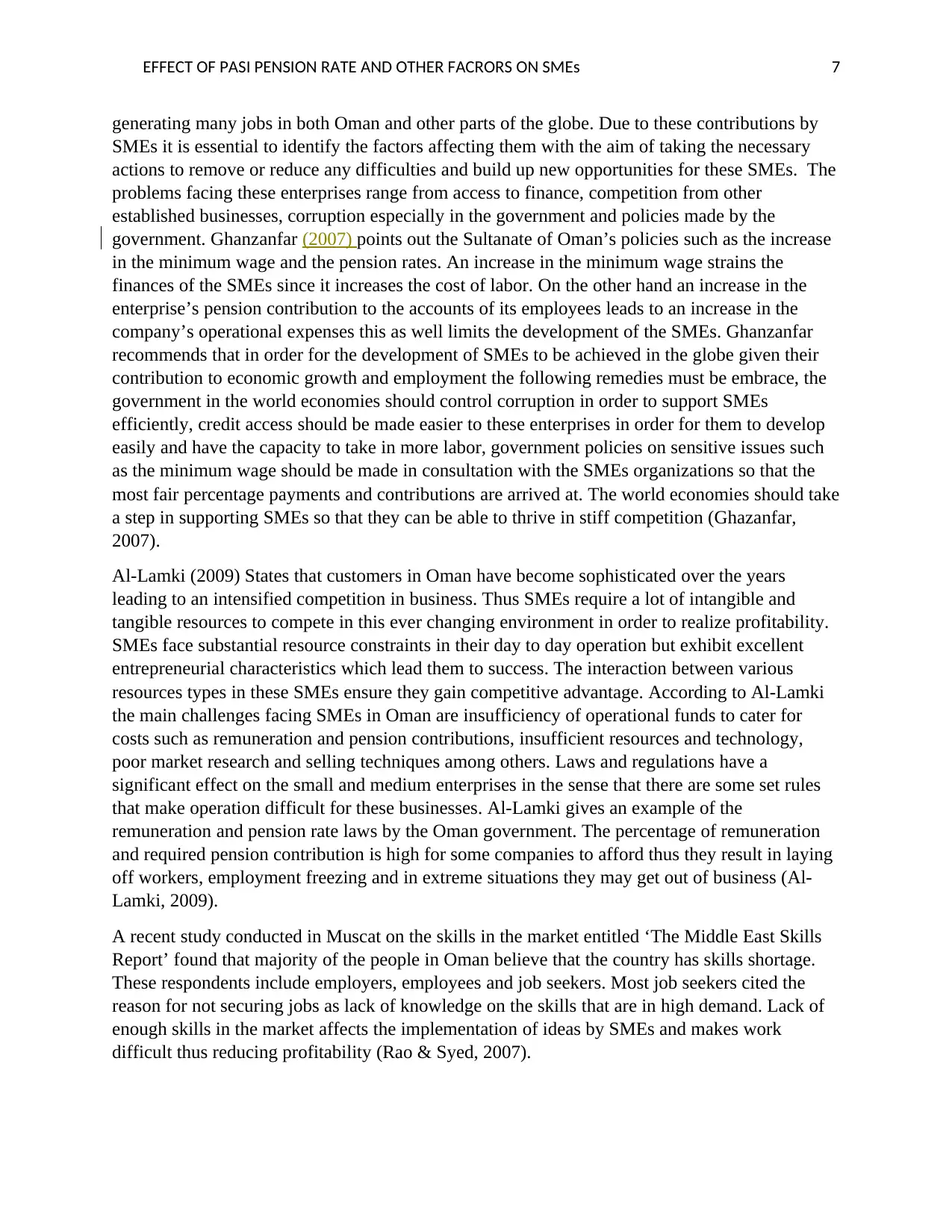
EFFECT OF PASI PENSION RATE AND OTHER FACRORS ON SMEs 7
generating many jobs in both Oman and other parts of the globe. Due to these contributions by
SMEs it is essential to identify the factors affecting them with the aim of taking the necessary
actions to remove or reduce any difficulties and build up new opportunities for these SMEs. The
problems facing these enterprises range from access to finance, competition from other
established businesses, corruption especially in the government and policies made by the
government. Ghanzanfar (2007) points out the Sultanate of Oman’s policies such as the increase
in the minimum wage and the pension rates. An increase in the minimum wage strains the
finances of the SMEs since it increases the cost of labor. On the other hand an increase in the
enterprise’s pension contribution to the accounts of its employees leads to an increase in the
company’s operational expenses this as well limits the development of the SMEs. Ghanzanfar
recommends that in order for the development of SMEs to be achieved in the globe given their
contribution to economic growth and employment the following remedies must be embrace, the
government in the world economies should control corruption in order to support SMEs
efficiently, credit access should be made easier to these enterprises in order for them to develop
easily and have the capacity to take in more labor, government policies on sensitive issues such
as the minimum wage should be made in consultation with the SMEs organizations so that the
most fair percentage payments and contributions are arrived at. The world economies should take
a step in supporting SMEs so that they can be able to thrive in stiff competition (Ghazanfar,
2007).
Al-Lamki (2009) States that customers in Oman have become sophisticated over the years
leading to an intensified competition in business. Thus SMEs require a lot of intangible and
tangible resources to compete in this ever changing environment in order to realize profitability.
SMEs face substantial resource constraints in their day to day operation but exhibit excellent
entrepreneurial characteristics which lead them to success. The interaction between various
resources types in these SMEs ensure they gain competitive advantage. According to Al-Lamki
the main challenges facing SMEs in Oman are insufficiency of operational funds to cater for
costs such as remuneration and pension contributions, insufficient resources and technology,
poor market research and selling techniques among others. Laws and regulations have a
significant effect on the small and medium enterprises in the sense that there are some set rules
that make operation difficult for these businesses. Al-Lamki gives an example of the
remuneration and pension rate laws by the Oman government. The percentage of remuneration
and required pension contribution is high for some companies to afford thus they result in laying
off workers, employment freezing and in extreme situations they may get out of business (Al-
Lamki, 2009).
A recent study conducted in Muscat on the skills in the market entitled ‘The Middle East Skills
Report’ found that majority of the people in Oman believe that the country has skills shortage.
These respondents include employers, employees and job seekers. Most job seekers cited the
reason for not securing jobs as lack of knowledge on the skills that are in high demand. Lack of
enough skills in the market affects the implementation of ideas by SMEs and makes work
difficult thus reducing profitability (Rao & Syed, 2007).
generating many jobs in both Oman and other parts of the globe. Due to these contributions by
SMEs it is essential to identify the factors affecting them with the aim of taking the necessary
actions to remove or reduce any difficulties and build up new opportunities for these SMEs. The
problems facing these enterprises range from access to finance, competition from other
established businesses, corruption especially in the government and policies made by the
government. Ghanzanfar (2007) points out the Sultanate of Oman’s policies such as the increase
in the minimum wage and the pension rates. An increase in the minimum wage strains the
finances of the SMEs since it increases the cost of labor. On the other hand an increase in the
enterprise’s pension contribution to the accounts of its employees leads to an increase in the
company’s operational expenses this as well limits the development of the SMEs. Ghanzanfar
recommends that in order for the development of SMEs to be achieved in the globe given their
contribution to economic growth and employment the following remedies must be embrace, the
government in the world economies should control corruption in order to support SMEs
efficiently, credit access should be made easier to these enterprises in order for them to develop
easily and have the capacity to take in more labor, government policies on sensitive issues such
as the minimum wage should be made in consultation with the SMEs organizations so that the
most fair percentage payments and contributions are arrived at. The world economies should take
a step in supporting SMEs so that they can be able to thrive in stiff competition (Ghazanfar,
2007).
Al-Lamki (2009) States that customers in Oman have become sophisticated over the years
leading to an intensified competition in business. Thus SMEs require a lot of intangible and
tangible resources to compete in this ever changing environment in order to realize profitability.
SMEs face substantial resource constraints in their day to day operation but exhibit excellent
entrepreneurial characteristics which lead them to success. The interaction between various
resources types in these SMEs ensure they gain competitive advantage. According to Al-Lamki
the main challenges facing SMEs in Oman are insufficiency of operational funds to cater for
costs such as remuneration and pension contributions, insufficient resources and technology,
poor market research and selling techniques among others. Laws and regulations have a
significant effect on the small and medium enterprises in the sense that there are some set rules
that make operation difficult for these businesses. Al-Lamki gives an example of the
remuneration and pension rate laws by the Oman government. The percentage of remuneration
and required pension contribution is high for some companies to afford thus they result in laying
off workers, employment freezing and in extreme situations they may get out of business (Al-
Lamki, 2009).
A recent study conducted in Muscat on the skills in the market entitled ‘The Middle East Skills
Report’ found that majority of the people in Oman believe that the country has skills shortage.
These respondents include employers, employees and job seekers. Most job seekers cited the
reason for not securing jobs as lack of knowledge on the skills that are in high demand. Lack of
enough skills in the market affects the implementation of ideas by SMEs and makes work
difficult thus reducing profitability (Rao & Syed, 2007).
Paraphrase This Document
Need a fresh take? Get an instant paraphrase of this document with our AI Paraphraser
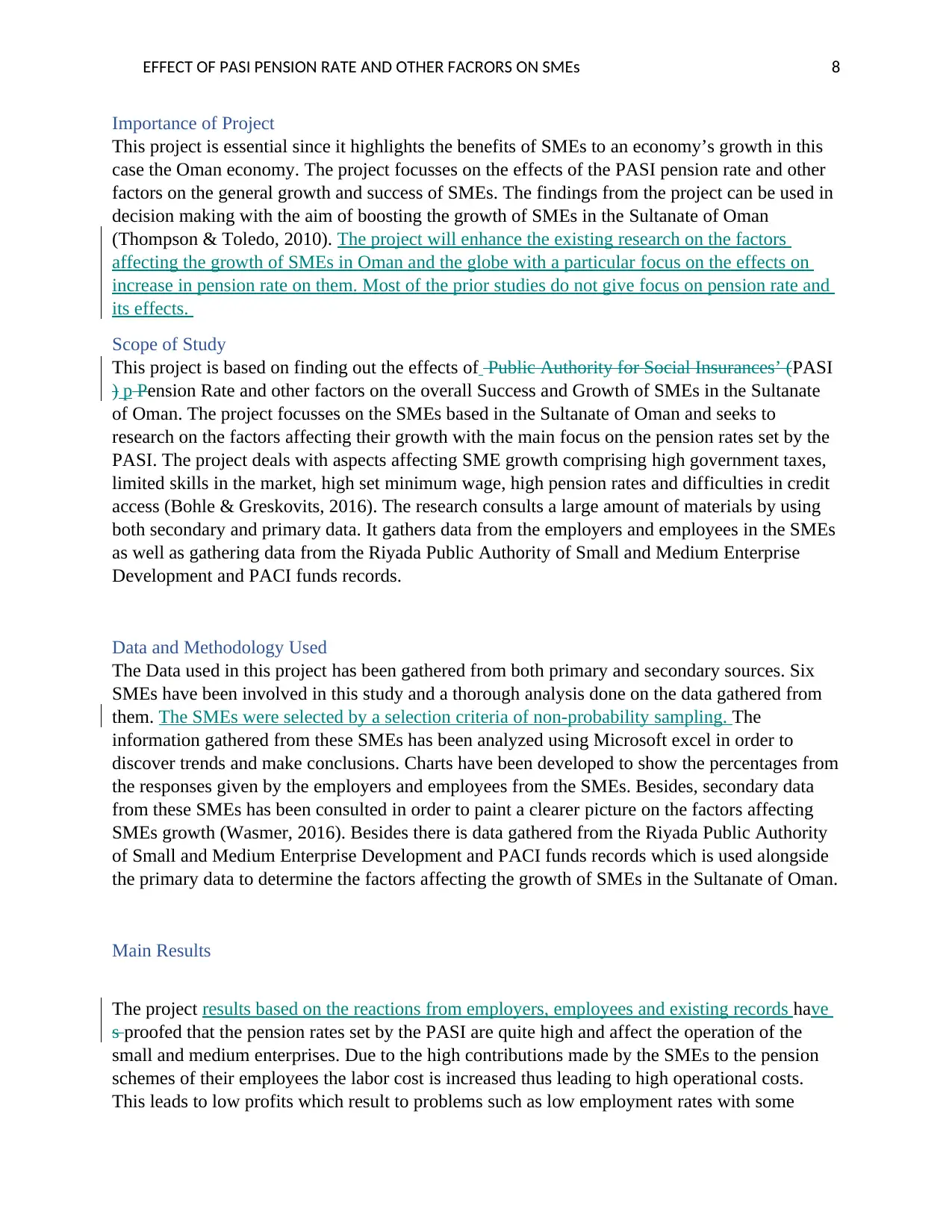
EFFECT OF PASI PENSION RATE AND OTHER FACRORS ON SMEs 8
Importance of Project
This project is essential since it highlights the benefits of SMEs to an economy’s growth in this
case the Oman economy. The project focusses on the effects of the PASI pension rate and other
factors on the general growth and success of SMEs. The findings from the project can be used in
decision making with the aim of boosting the growth of SMEs in the Sultanate of Oman
(Thompson & Toledo, 2010). The project will enhance the existing research on the factors
affecting the growth of SMEs in Oman and the globe with a particular focus on the effects on
increase in pension rate on them. Most of the prior studies do not give focus on pension rate and
its effects.
Scope of Study
This project is based on finding out the effects of Public Authority for Social Insurances’ (PASI
) p Pension Rate and other factors on the overall Success and Growth of SMEs in the Sultanate
of Oman. The project focusses on the SMEs based in the Sultanate of Oman and seeks to
research on the factors affecting their growth with the main focus on the pension rates set by the
PASI. The project deals with aspects affecting SME growth comprising high government taxes,
limited skills in the market, high set minimum wage, high pension rates and difficulties in credit
access (Bohle & Greskovits, 2016). The research consults a large amount of materials by using
both secondary and primary data. It gathers data from the employers and employees in the SMEs
as well as gathering data from the Riyada Public Authority of Small and Medium Enterprise
Development and PACI funds records.
Data and Methodology Used
The Data used in this project has been gathered from both primary and secondary sources. Six
SMEs have been involved in this study and a thorough analysis done on the data gathered from
them. The SMEs were selected by a selection criteria of non-probability sampling. The
information gathered from these SMEs has been analyzed using Microsoft excel in order to
discover trends and make conclusions. Charts have been developed to show the percentages from
the responses given by the employers and employees from the SMEs. Besides, secondary data
from these SMEs has been consulted in order to paint a clearer picture on the factors affecting
SMEs growth (Wasmer, 2016). Besides there is data gathered from the Riyada Public Authority
of Small and Medium Enterprise Development and PACI funds records which is used alongside
the primary data to determine the factors affecting the growth of SMEs in the Sultanate of Oman.
Main Results
The project results based on the reactions from employers, employees and existing records have
s proofed that the pension rates set by the PASI are quite high and affect the operation of the
small and medium enterprises. Due to the high contributions made by the SMEs to the pension
schemes of their employees the labor cost is increased thus leading to high operational costs.
This leads to low profits which result to problems such as low employment rates with some
Importance of Project
This project is essential since it highlights the benefits of SMEs to an economy’s growth in this
case the Oman economy. The project focusses on the effects of the PASI pension rate and other
factors on the general growth and success of SMEs. The findings from the project can be used in
decision making with the aim of boosting the growth of SMEs in the Sultanate of Oman
(Thompson & Toledo, 2010). The project will enhance the existing research on the factors
affecting the growth of SMEs in Oman and the globe with a particular focus on the effects on
increase in pension rate on them. Most of the prior studies do not give focus on pension rate and
its effects.
Scope of Study
This project is based on finding out the effects of Public Authority for Social Insurances’ (PASI
) p Pension Rate and other factors on the overall Success and Growth of SMEs in the Sultanate
of Oman. The project focusses on the SMEs based in the Sultanate of Oman and seeks to
research on the factors affecting their growth with the main focus on the pension rates set by the
PASI. The project deals with aspects affecting SME growth comprising high government taxes,
limited skills in the market, high set minimum wage, high pension rates and difficulties in credit
access (Bohle & Greskovits, 2016). The research consults a large amount of materials by using
both secondary and primary data. It gathers data from the employers and employees in the SMEs
as well as gathering data from the Riyada Public Authority of Small and Medium Enterprise
Development and PACI funds records.
Data and Methodology Used
The Data used in this project has been gathered from both primary and secondary sources. Six
SMEs have been involved in this study and a thorough analysis done on the data gathered from
them. The SMEs were selected by a selection criteria of non-probability sampling. The
information gathered from these SMEs has been analyzed using Microsoft excel in order to
discover trends and make conclusions. Charts have been developed to show the percentages from
the responses given by the employers and employees from the SMEs. Besides, secondary data
from these SMEs has been consulted in order to paint a clearer picture on the factors affecting
SMEs growth (Wasmer, 2016). Besides there is data gathered from the Riyada Public Authority
of Small and Medium Enterprise Development and PACI funds records which is used alongside
the primary data to determine the factors affecting the growth of SMEs in the Sultanate of Oman.
Main Results
The project results based on the reactions from employers, employees and existing records have
s proofed that the pension rates set by the PASI are quite high and affect the operation of the
small and medium enterprises. Due to the high contributions made by the SMEs to the pension
schemes of their employees the labor cost is increased thus leading to high operational costs.
This leads to low profits which result to problems such as low employment rates with some
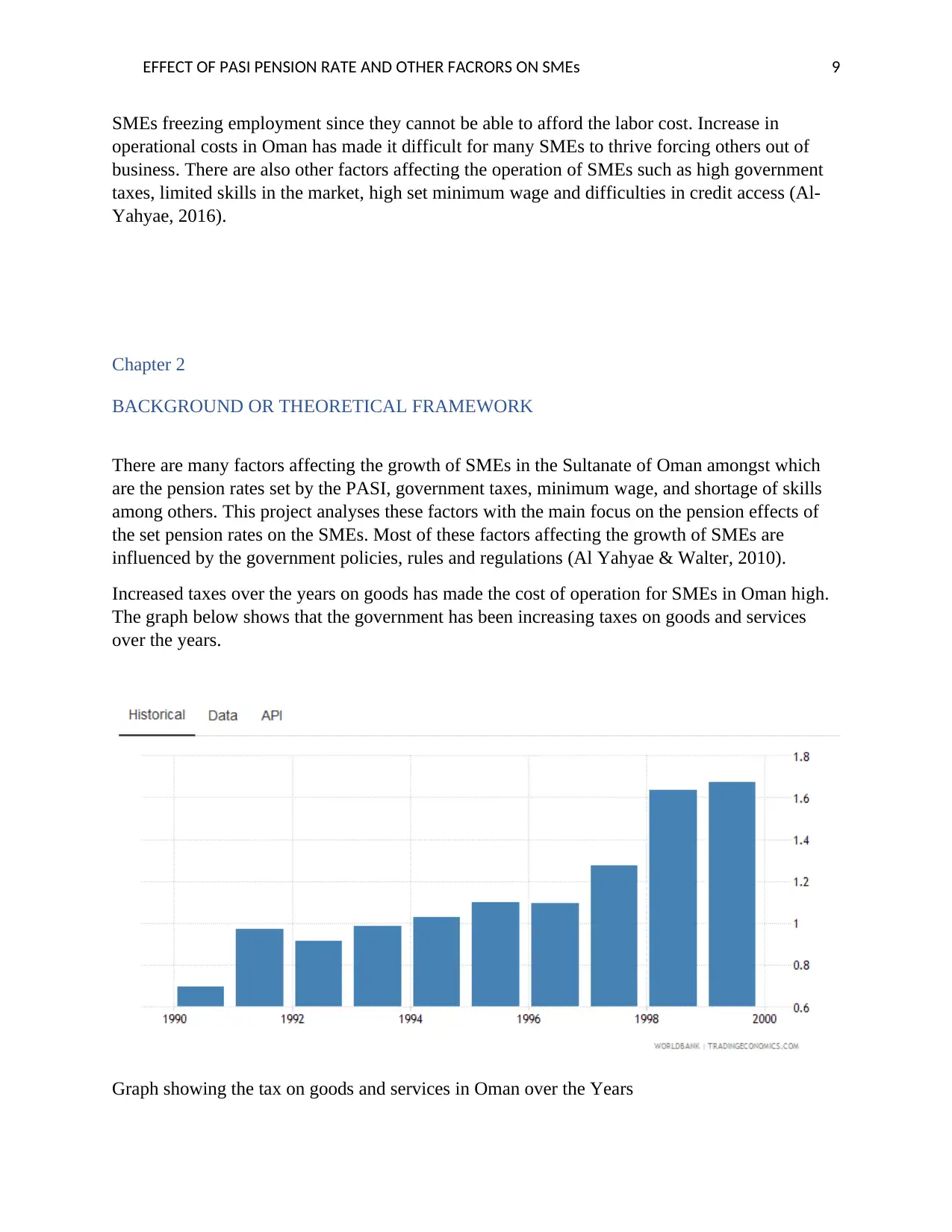
EFFECT OF PASI PENSION RATE AND OTHER FACRORS ON SMEs 9
SMEs freezing employment since they cannot be able to afford the labor cost. Increase in
operational costs in Oman has made it difficult for many SMEs to thrive forcing others out of
business. There are also other factors affecting the operation of SMEs such as high government
taxes, limited skills in the market, high set minimum wage and difficulties in credit access (Al-
Yahyae, 2016).
Chapter 2
BACKGROUND OR THEORETICAL FRAMEWORK
There are many factors affecting the growth of SMEs in the Sultanate of Oman amongst which
are the pension rates set by the PASI, government taxes, minimum wage, and shortage of skills
among others. This project analyses these factors with the main focus on the pension effects of
the set pension rates on the SMEs. Most of these factors affecting the growth of SMEs are
influenced by the government policies, rules and regulations (Al Yahyae & Walter, 2010).
Increased taxes over the years on goods has made the cost of operation for SMEs in Oman high.
The graph below shows that the government has been increasing taxes on goods and services
over the years.
Graph showing the tax on goods and services in Oman over the Years
SMEs freezing employment since they cannot be able to afford the labor cost. Increase in
operational costs in Oman has made it difficult for many SMEs to thrive forcing others out of
business. There are also other factors affecting the operation of SMEs such as high government
taxes, limited skills in the market, high set minimum wage and difficulties in credit access (Al-
Yahyae, 2016).
Chapter 2
BACKGROUND OR THEORETICAL FRAMEWORK
There are many factors affecting the growth of SMEs in the Sultanate of Oman amongst which
are the pension rates set by the PASI, government taxes, minimum wage, and shortage of skills
among others. This project analyses these factors with the main focus on the pension effects of
the set pension rates on the SMEs. Most of these factors affecting the growth of SMEs are
influenced by the government policies, rules and regulations (Al Yahyae & Walter, 2010).
Increased taxes over the years on goods has made the cost of operation for SMEs in Oman high.
The graph below shows that the government has been increasing taxes on goods and services
over the years.
Graph showing the tax on goods and services in Oman over the Years
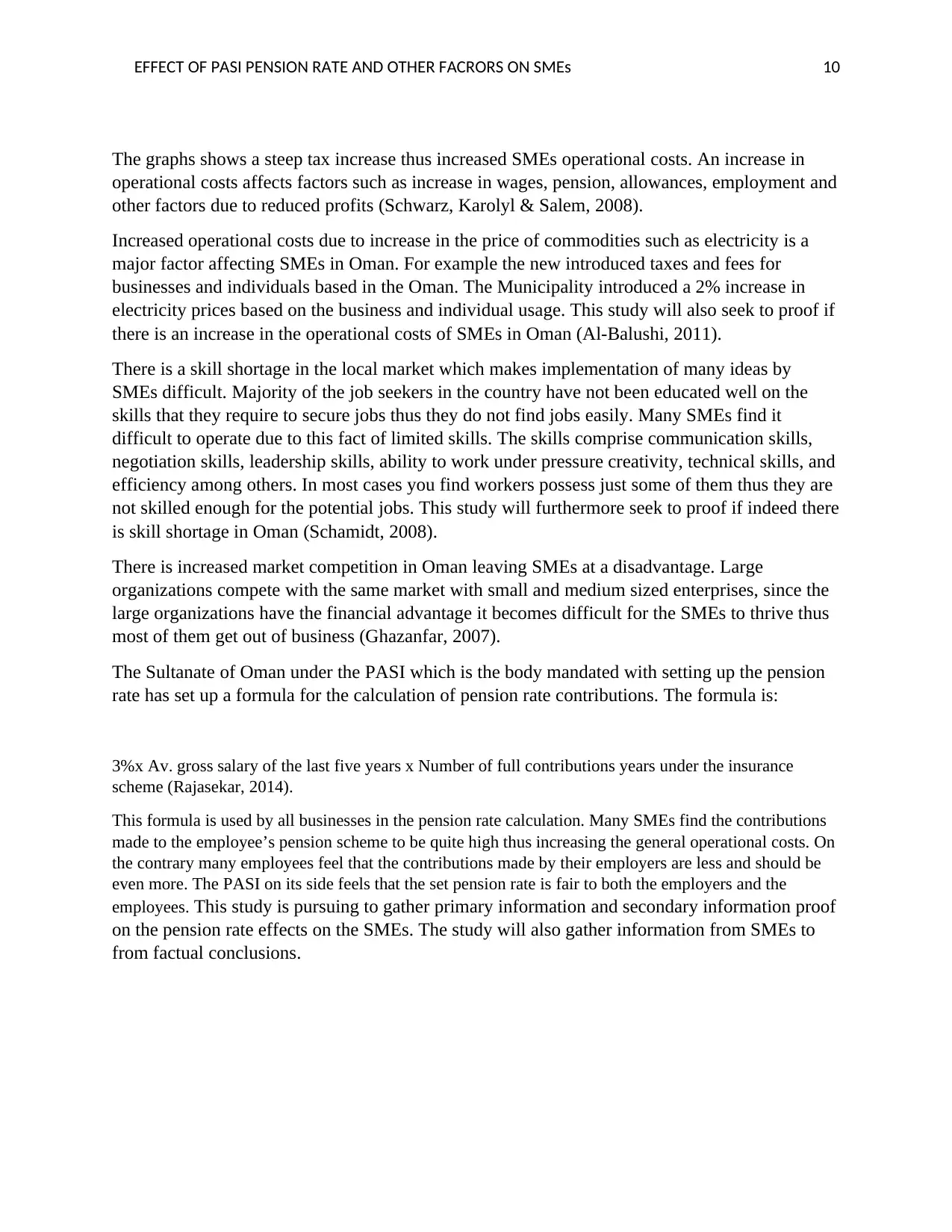
EFFECT OF PASI PENSION RATE AND OTHER FACRORS ON SMEs 10
The graphs shows a steep tax increase thus increased SMEs operational costs. An increase in
operational costs affects factors such as increase in wages, pension, allowances, employment and
other factors due to reduced profits (Schwarz, Karolyl & Salem, 2008).
Increased operational costs due to increase in the price of commodities such as electricity is a
major factor affecting SMEs in Oman. For example the new introduced taxes and fees for
businesses and individuals based in the Oman. The Municipality introduced a 2% increase in
electricity prices based on the business and individual usage. This study will also seek to proof if
there is an increase in the operational costs of SMEs in Oman (Al-Balushi, 2011).
There is a skill shortage in the local market which makes implementation of many ideas by
SMEs difficult. Majority of the job seekers in the country have not been educated well on the
skills that they require to secure jobs thus they do not find jobs easily. Many SMEs find it
difficult to operate due to this fact of limited skills. The skills comprise communication skills,
negotiation skills, leadership skills, ability to work under pressure creativity, technical skills, and
efficiency among others. In most cases you find workers possess just some of them thus they are
not skilled enough for the potential jobs. This study will furthermore seek to proof if indeed there
is skill shortage in Oman (Schamidt, 2008).
There is increased market competition in Oman leaving SMEs at a disadvantage. Large
organizations compete with the same market with small and medium sized enterprises, since the
large organizations have the financial advantage it becomes difficult for the SMEs to thrive thus
most of them get out of business (Ghazanfar, 2007).
The Sultanate of Oman under the PASI which is the body mandated with setting up the pension
rate has set up a formula for the calculation of pension rate contributions. The formula is:
3%x Av. gross salary of the last five years x Number of full contributions years under the insurance
scheme (Rajasekar, 2014).
This formula is used by all businesses in the pension rate calculation. Many SMEs find the contributions
made to the employee’s pension scheme to be quite high thus increasing the general operational costs. On
the contrary many employees feel that the contributions made by their employers are less and should be
even more. The PASI on its side feels that the set pension rate is fair to both the employers and the
employees. This study is pursuing to gather primary information and secondary information proof
on the pension rate effects on the SMEs. The study will also gather information from SMEs to
from factual conclusions.
The graphs shows a steep tax increase thus increased SMEs operational costs. An increase in
operational costs affects factors such as increase in wages, pension, allowances, employment and
other factors due to reduced profits (Schwarz, Karolyl & Salem, 2008).
Increased operational costs due to increase in the price of commodities such as electricity is a
major factor affecting SMEs in Oman. For example the new introduced taxes and fees for
businesses and individuals based in the Oman. The Municipality introduced a 2% increase in
electricity prices based on the business and individual usage. This study will also seek to proof if
there is an increase in the operational costs of SMEs in Oman (Al-Balushi, 2011).
There is a skill shortage in the local market which makes implementation of many ideas by
SMEs difficult. Majority of the job seekers in the country have not been educated well on the
skills that they require to secure jobs thus they do not find jobs easily. Many SMEs find it
difficult to operate due to this fact of limited skills. The skills comprise communication skills,
negotiation skills, leadership skills, ability to work under pressure creativity, technical skills, and
efficiency among others. In most cases you find workers possess just some of them thus they are
not skilled enough for the potential jobs. This study will furthermore seek to proof if indeed there
is skill shortage in Oman (Schamidt, 2008).
There is increased market competition in Oman leaving SMEs at a disadvantage. Large
organizations compete with the same market with small and medium sized enterprises, since the
large organizations have the financial advantage it becomes difficult for the SMEs to thrive thus
most of them get out of business (Ghazanfar, 2007).
The Sultanate of Oman under the PASI which is the body mandated with setting up the pension
rate has set up a formula for the calculation of pension rate contributions. The formula is:
3%x Av. gross salary of the last five years x Number of full contributions years under the insurance
scheme (Rajasekar, 2014).
This formula is used by all businesses in the pension rate calculation. Many SMEs find the contributions
made to the employee’s pension scheme to be quite high thus increasing the general operational costs. On
the contrary many employees feel that the contributions made by their employers are less and should be
even more. The PASI on its side feels that the set pension rate is fair to both the employers and the
employees. This study is pursuing to gather primary information and secondary information proof
on the pension rate effects on the SMEs. The study will also gather information from SMEs to
from factual conclusions.
Secure Best Marks with AI Grader
Need help grading? Try our AI Grader for instant feedback on your assignments.
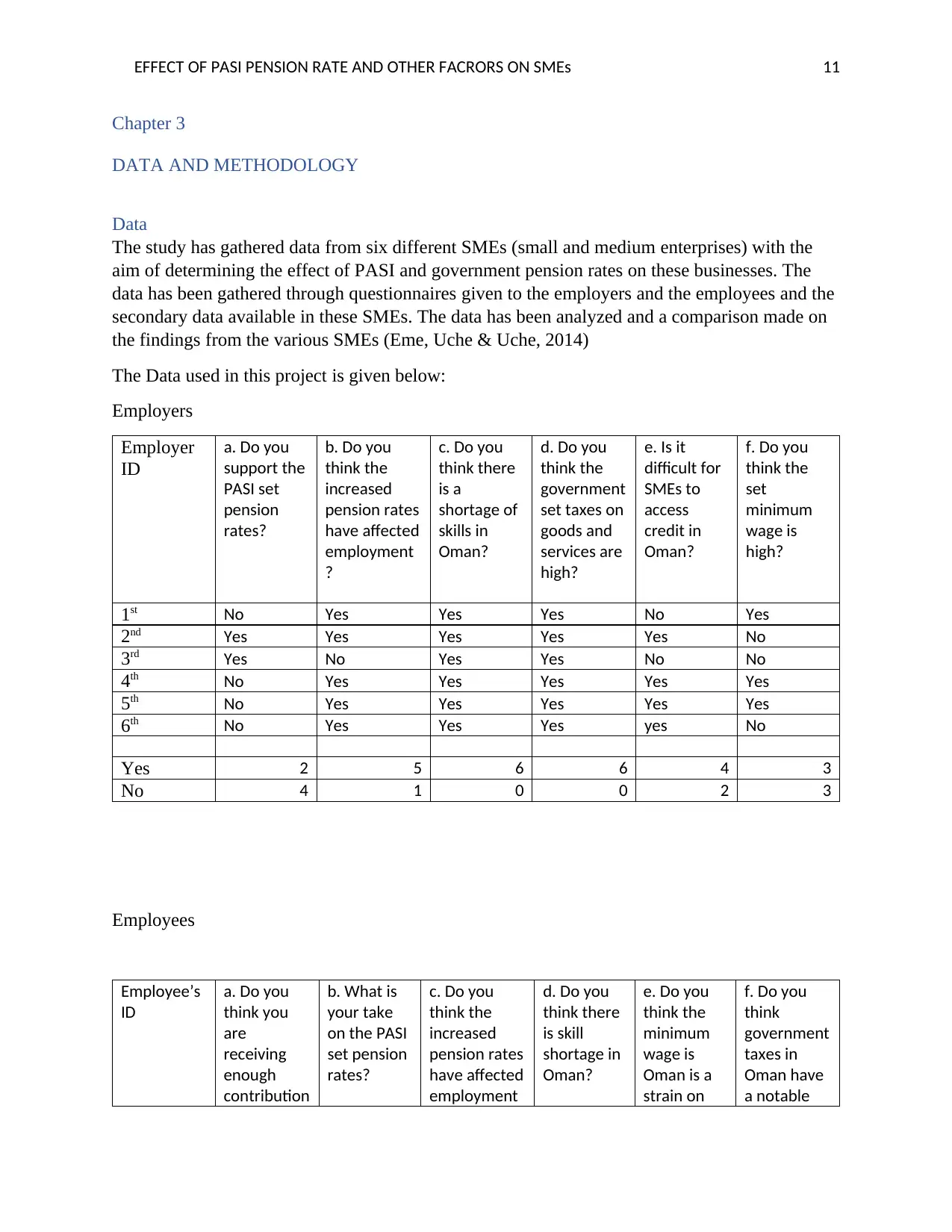
EFFECT OF PASI PENSION RATE AND OTHER FACRORS ON SMEs 11
Chapter 3
DATA AND METHODOLOGY
Data
The study has gathered data from six different SMEs (small and medium enterprises) with the
aim of determining the effect of PASI and government pension rates on these businesses. The
data has been gathered through questionnaires given to the employers and the employees and the
secondary data available in these SMEs. The data has been analyzed and a comparison made on
the findings from the various SMEs (Eme, Uche & Uche, 2014)
The Data used in this project is given below:
Employers
Employer
ID
a. Do you
support the
PASI set
pension
rates?
b. Do you
think the
increased
pension rates
have affected
employment
?
c. Do you
think there
is a
shortage of
skills in
Oman?
d. Do you
think the
government
set taxes on
goods and
services are
high?
e. Is it
difficult for
SMEs to
access
credit in
Oman?
f. Do you
think the
set
minimum
wage is
high?
1st No Yes Yes Yes No Yes
2nd Yes Yes Yes Yes Yes No
3rd Yes No Yes Yes No No
4th No Yes Yes Yes Yes Yes
5th No Yes Yes Yes Yes Yes
6th No Yes Yes Yes yes No
Yes 2 5 6 6 4 3
No 4 1 0 0 2 3
Employees
Employee’s
ID
a. Do you
think you
are
receiving
enough
contribution
b. What is
your take
on the PASI
set pension
rates?
c. Do you
think the
increased
pension rates
have affected
employment
d. Do you
think there
is skill
shortage in
Oman?
e. Do you
think the
minimum
wage is
Oman is a
strain on
f. Do you
think
government
taxes in
Oman have
a notable
Chapter 3
DATA AND METHODOLOGY
Data
The study has gathered data from six different SMEs (small and medium enterprises) with the
aim of determining the effect of PASI and government pension rates on these businesses. The
data has been gathered through questionnaires given to the employers and the employees and the
secondary data available in these SMEs. The data has been analyzed and a comparison made on
the findings from the various SMEs (Eme, Uche & Uche, 2014)
The Data used in this project is given below:
Employers
Employer
ID
a. Do you
support the
PASI set
pension
rates?
b. Do you
think the
increased
pension rates
have affected
employment
?
c. Do you
think there
is a
shortage of
skills in
Oman?
d. Do you
think the
government
set taxes on
goods and
services are
high?
e. Is it
difficult for
SMEs to
access
credit in
Oman?
f. Do you
think the
set
minimum
wage is
high?
1st No Yes Yes Yes No Yes
2nd Yes Yes Yes Yes Yes No
3rd Yes No Yes Yes No No
4th No Yes Yes Yes Yes Yes
5th No Yes Yes Yes Yes Yes
6th No Yes Yes Yes yes No
Yes 2 5 6 6 4 3
No 4 1 0 0 2 3
Employees
Employee’s
ID
a. Do you
think you
are
receiving
enough
contribution
b. What is
your take
on the PASI
set pension
rates?
c. Do you
think the
increased
pension rates
have affected
employment
d. Do you
think there
is skill
shortage in
Oman?
e. Do you
think the
minimum
wage is
Oman is a
strain on
f. Do you
think
government
taxes in
Oman have
a notable
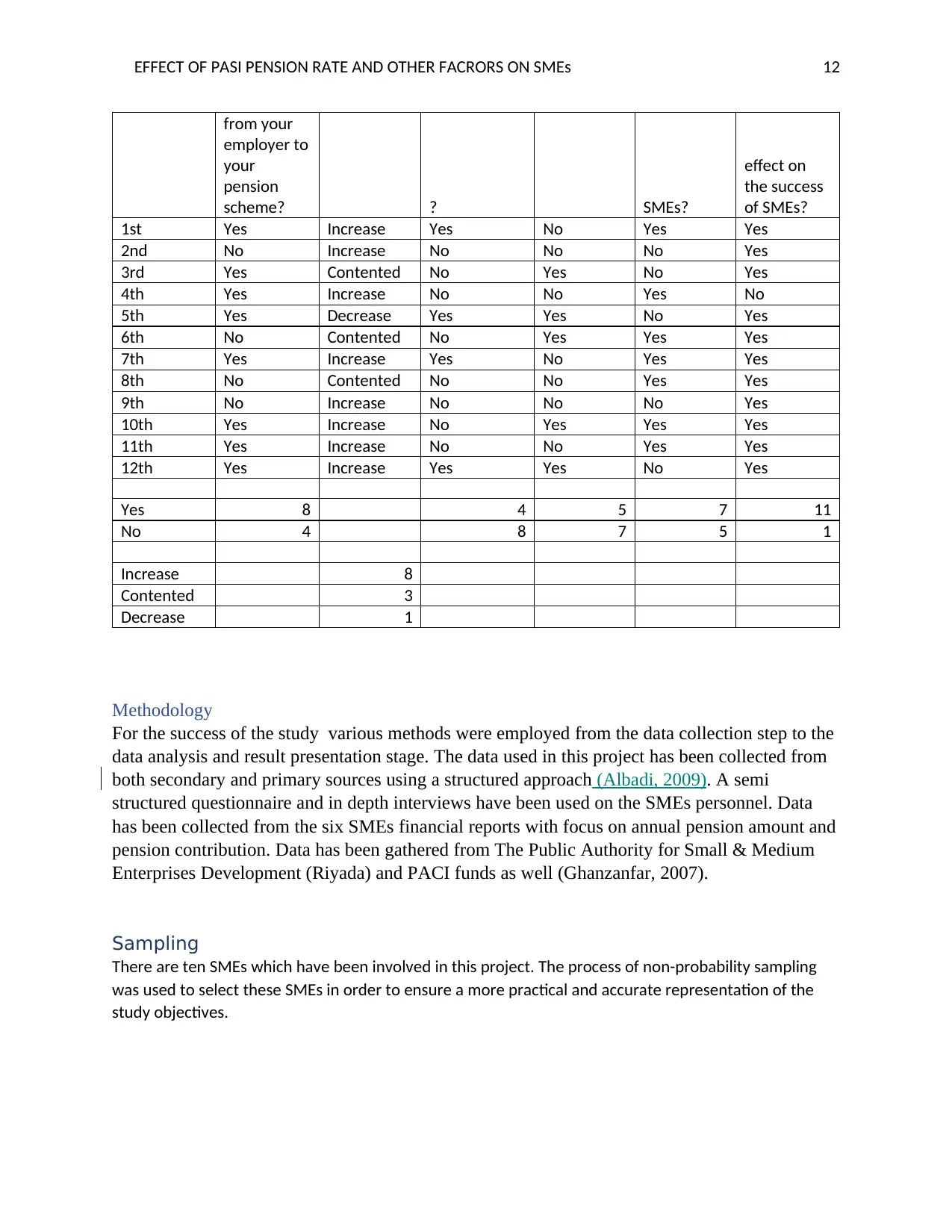
EFFECT OF PASI PENSION RATE AND OTHER FACRORS ON SMEs 12
from your
employer to
your
pension
scheme? ? SMEs?
effect on
the success
of SMEs?
1st Yes Increase Yes No Yes Yes
2nd No Increase No No No Yes
3rd Yes Contented No Yes No Yes
4th Yes Increase No No Yes No
5th Yes Decrease Yes Yes No Yes
6th No Contented No Yes Yes Yes
7th Yes Increase Yes No Yes Yes
8th No Contented No No Yes Yes
9th No Increase No No No Yes
10th Yes Increase No Yes Yes Yes
11th Yes Increase No No Yes Yes
12th Yes Increase Yes Yes No Yes
Yes 8 4 5 7 11
No 4 8 7 5 1
Increase 8
Contented 3
Decrease 1
Methodology
For the success of the study various methods were employed from the data collection step to the
data analysis and result presentation stage. The data used in this project has been collected from
both secondary and primary sources using a structured approach (Albadi, 2009). A semi
structured questionnaire and in depth interviews have been used on the SMEs personnel. Data
has been collected from the six SMEs financial reports with focus on annual pension amount and
pension contribution. Data has been gathered from The Public Authority for Small & Medium
Enterprises Development (Riyada) and PACI funds as well (Ghanzanfar, 2007).
Sampling
There are ten SMEs which have been involved in this project. The process of non-probability sampling
was used to select these SMEs in order to ensure a more practical and accurate representation of the
study objectives.
from your
employer to
your
pension
scheme? ? SMEs?
effect on
the success
of SMEs?
1st Yes Increase Yes No Yes Yes
2nd No Increase No No No Yes
3rd Yes Contented No Yes No Yes
4th Yes Increase No No Yes No
5th Yes Decrease Yes Yes No Yes
6th No Contented No Yes Yes Yes
7th Yes Increase Yes No Yes Yes
8th No Contented No No Yes Yes
9th No Increase No No No Yes
10th Yes Increase No Yes Yes Yes
11th Yes Increase No No Yes Yes
12th Yes Increase Yes Yes No Yes
Yes 8 4 5 7 11
No 4 8 7 5 1
Increase 8
Contented 3
Decrease 1
Methodology
For the success of the study various methods were employed from the data collection step to the
data analysis and result presentation stage. The data used in this project has been collected from
both secondary and primary sources using a structured approach (Albadi, 2009). A semi
structured questionnaire and in depth interviews have been used on the SMEs personnel. Data
has been collected from the six SMEs financial reports with focus on annual pension amount and
pension contribution. Data has been gathered from The Public Authority for Small & Medium
Enterprises Development (Riyada) and PACI funds as well (Ghanzanfar, 2007).
Sampling
There are ten SMEs which have been involved in this project. The process of non-probability sampling
was used to select these SMEs in order to ensure a more practical and accurate representation of the
study objectives.
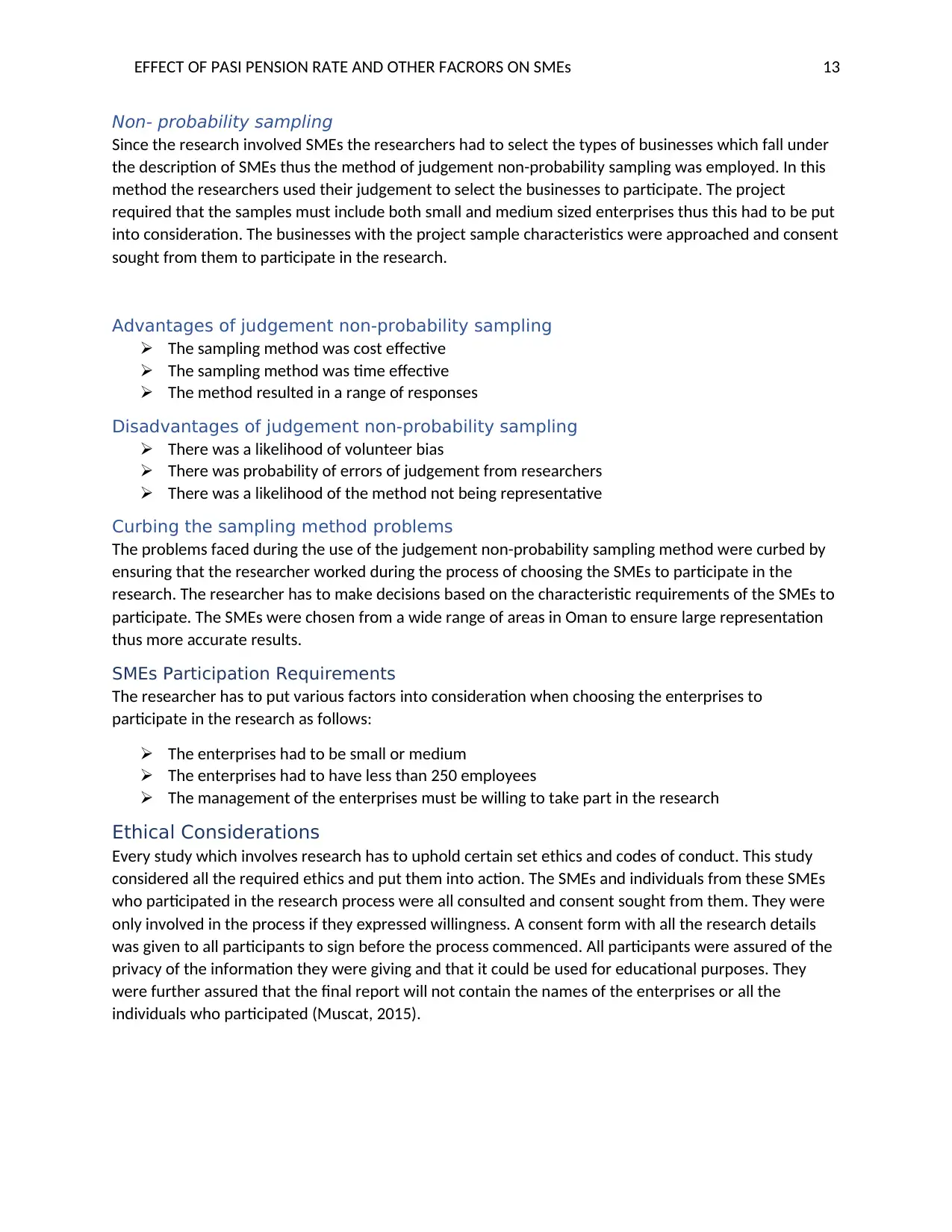
EFFECT OF PASI PENSION RATE AND OTHER FACRORS ON SMEs 13
Non- probability sampling
Since the research involved SMEs the researchers had to select the types of businesses which fall under
the description of SMEs thus the method of judgement non-probability sampling was employed. In this
method the researchers used their judgement to select the businesses to participate. The project
required that the samples must include both small and medium sized enterprises thus this had to be put
into consideration. The businesses with the project sample characteristics were approached and consent
sought from them to participate in the research.
Advantages of judgement non-probability sampling
The sampling method was cost effective
The sampling method was time effective
The method resulted in a range of responses
Disadvantages of judgement non-probability sampling
There was a likelihood of volunteer bias
There was probability of errors of judgement from researchers
There was a likelihood of the method not being representative
Curbing the sampling method problems
The problems faced during the use of the judgement non-probability sampling method were curbed by
ensuring that the researcher worked during the process of choosing the SMEs to participate in the
research. The researcher has to make decisions based on the characteristic requirements of the SMEs to
participate. The SMEs were chosen from a wide range of areas in Oman to ensure large representation
thus more accurate results.
SMEs Participation Requirements
The researcher has to put various factors into consideration when choosing the enterprises to
participate in the research as follows:
The enterprises had to be small or medium
The enterprises had to have less than 250 employees
The management of the enterprises must be willing to take part in the research
Ethical Considerations
Every study which involves research has to uphold certain set ethics and codes of conduct. This study
considered all the required ethics and put them into action. The SMEs and individuals from these SMEs
who participated in the research process were all consulted and consent sought from them. They were
only involved in the process if they expressed willingness. A consent form with all the research details
was given to all participants to sign before the process commenced. All participants were assured of the
privacy of the information they were giving and that it could be used for educational purposes. They
were further assured that the final report will not contain the names of the enterprises or all the
individuals who participated (Muscat, 2015).
Non- probability sampling
Since the research involved SMEs the researchers had to select the types of businesses which fall under
the description of SMEs thus the method of judgement non-probability sampling was employed. In this
method the researchers used their judgement to select the businesses to participate. The project
required that the samples must include both small and medium sized enterprises thus this had to be put
into consideration. The businesses with the project sample characteristics were approached and consent
sought from them to participate in the research.
Advantages of judgement non-probability sampling
The sampling method was cost effective
The sampling method was time effective
The method resulted in a range of responses
Disadvantages of judgement non-probability sampling
There was a likelihood of volunteer bias
There was probability of errors of judgement from researchers
There was a likelihood of the method not being representative
Curbing the sampling method problems
The problems faced during the use of the judgement non-probability sampling method were curbed by
ensuring that the researcher worked during the process of choosing the SMEs to participate in the
research. The researcher has to make decisions based on the characteristic requirements of the SMEs to
participate. The SMEs were chosen from a wide range of areas in Oman to ensure large representation
thus more accurate results.
SMEs Participation Requirements
The researcher has to put various factors into consideration when choosing the enterprises to
participate in the research as follows:
The enterprises had to be small or medium
The enterprises had to have less than 250 employees
The management of the enterprises must be willing to take part in the research
Ethical Considerations
Every study which involves research has to uphold certain set ethics and codes of conduct. This study
considered all the required ethics and put them into action. The SMEs and individuals from these SMEs
who participated in the research process were all consulted and consent sought from them. They were
only involved in the process if they expressed willingness. A consent form with all the research details
was given to all participants to sign before the process commenced. All participants were assured of the
privacy of the information they were giving and that it could be used for educational purposes. They
were further assured that the final report will not contain the names of the enterprises or all the
individuals who participated (Muscat, 2015).
Paraphrase This Document
Need a fresh take? Get an instant paraphrase of this document with our AI Paraphraser
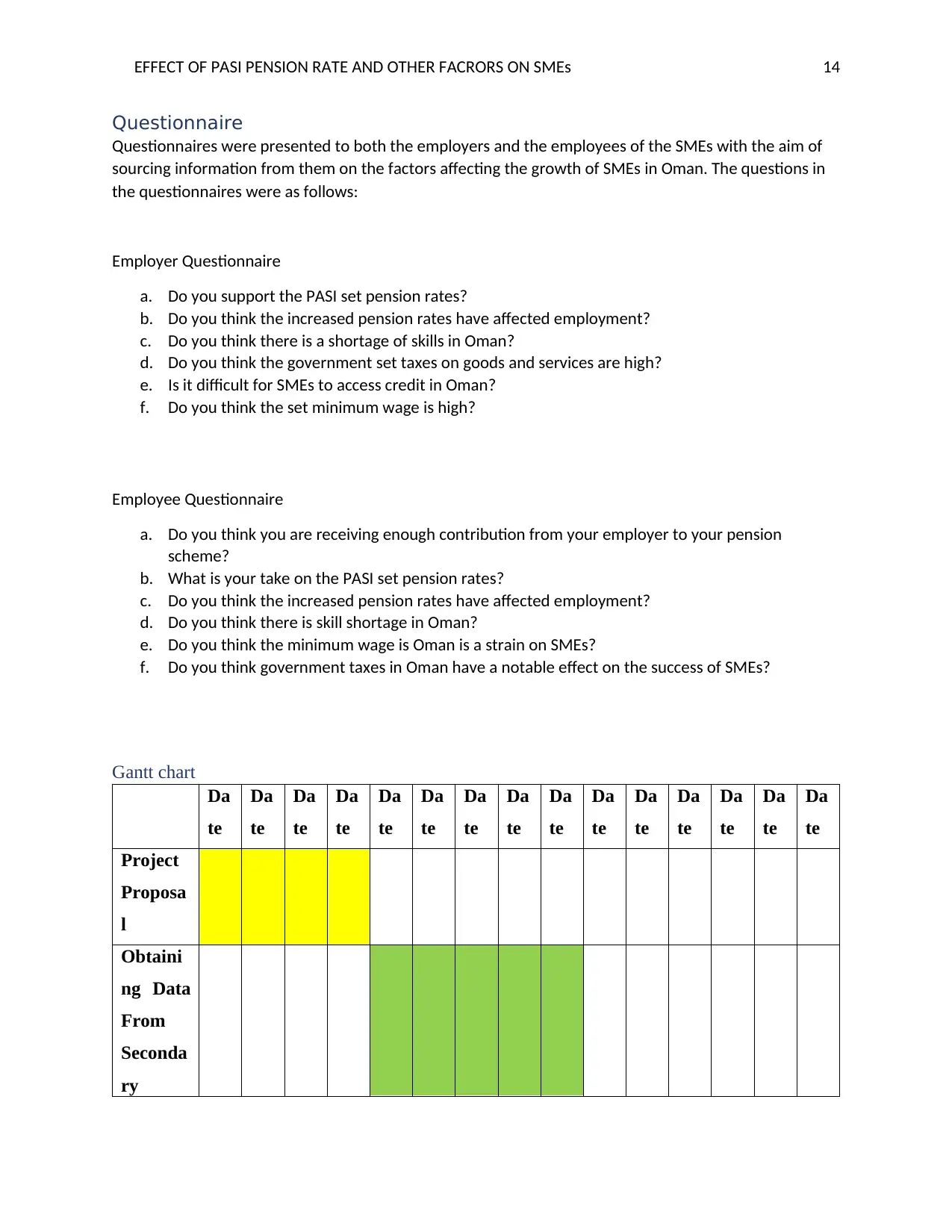
EFFECT OF PASI PENSION RATE AND OTHER FACRORS ON SMEs 14
Questionnaire
Questionnaires were presented to both the employers and the employees of the SMEs with the aim of
sourcing information from them on the factors affecting the growth of SMEs in Oman. The questions in
the questionnaires were as follows:
Employer Questionnaire
a. Do you support the PASI set pension rates?
b. Do you think the increased pension rates have affected employment?
c. Do you think there is a shortage of skills in Oman?
d. Do you think the government set taxes on goods and services are high?
e. Is it difficult for SMEs to access credit in Oman?
f. Do you think the set minimum wage is high?
Employee Questionnaire
a. Do you think you are receiving enough contribution from your employer to your pension
scheme?
b. What is your take on the PASI set pension rates?
c. Do you think the increased pension rates have affected employment?
d. Do you think there is skill shortage in Oman?
e. Do you think the minimum wage is Oman is a strain on SMEs?
f. Do you think government taxes in Oman have a notable effect on the success of SMEs?
Gantt chart
Da
te
Da
te
Da
te
Da
te
Da
te
Da
te
Da
te
Da
te
Da
te
Da
te
Da
te
Da
te
Da
te
Da
te
Da
te
Project
Proposa
l
Obtaini
ng Data
From
Seconda
ry
Questionnaire
Questionnaires were presented to both the employers and the employees of the SMEs with the aim of
sourcing information from them on the factors affecting the growth of SMEs in Oman. The questions in
the questionnaires were as follows:
Employer Questionnaire
a. Do you support the PASI set pension rates?
b. Do you think the increased pension rates have affected employment?
c. Do you think there is a shortage of skills in Oman?
d. Do you think the government set taxes on goods and services are high?
e. Is it difficult for SMEs to access credit in Oman?
f. Do you think the set minimum wage is high?
Employee Questionnaire
a. Do you think you are receiving enough contribution from your employer to your pension
scheme?
b. What is your take on the PASI set pension rates?
c. Do you think the increased pension rates have affected employment?
d. Do you think there is skill shortage in Oman?
e. Do you think the minimum wage is Oman is a strain on SMEs?
f. Do you think government taxes in Oman have a notable effect on the success of SMEs?
Gantt chart
Da
te
Da
te
Da
te
Da
te
Da
te
Da
te
Da
te
Da
te
Da
te
Da
te
Da
te
Da
te
Da
te
Da
te
Da
te
Project
Proposa
l
Obtaini
ng Data
From
Seconda
ry
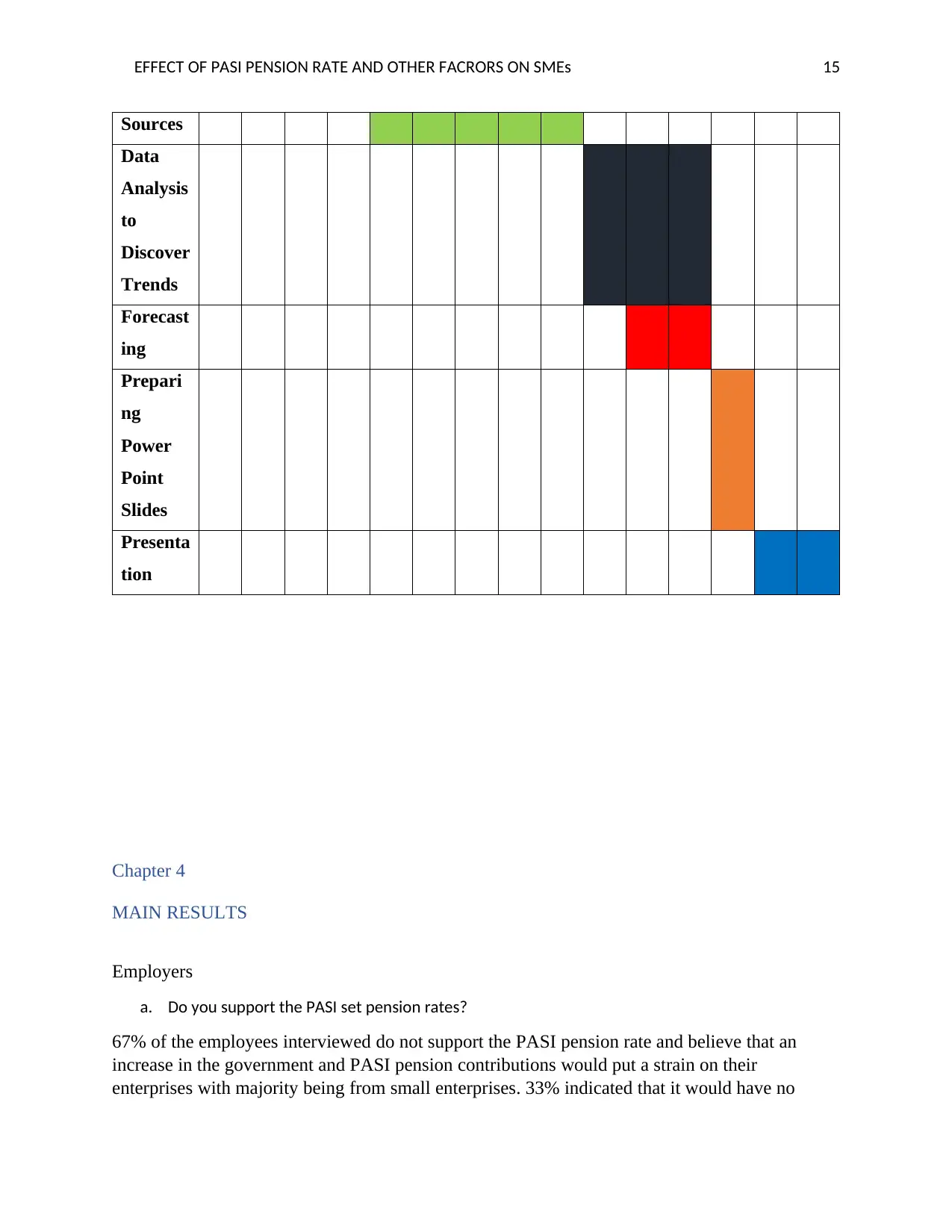
EFFECT OF PASI PENSION RATE AND OTHER FACRORS ON SMEs 15
Sources
Data
Analysis
to
Discover
Trends
Forecast
ing
Prepari
ng
Power
Point
Slides
Presenta
tion
Chapter 4
MAIN RESULTS
Employers
a. Do you support the PASI set pension rates?
67% of the employees interviewed do not support the PASI pension rate and believe that an
increase in the government and PASI pension contributions would put a strain on their
enterprises with majority being from small enterprises. 33% indicated that it would have no
Sources
Data
Analysis
to
Discover
Trends
Forecast
ing
Prepari
ng
Power
Point
Slides
Presenta
tion
Chapter 4
MAIN RESULTS
Employers
a. Do you support the PASI set pension rates?
67% of the employees interviewed do not support the PASI pension rate and believe that an
increase in the government and PASI pension contributions would put a strain on their
enterprises with majority being from small enterprises. 33% indicated that it would have no
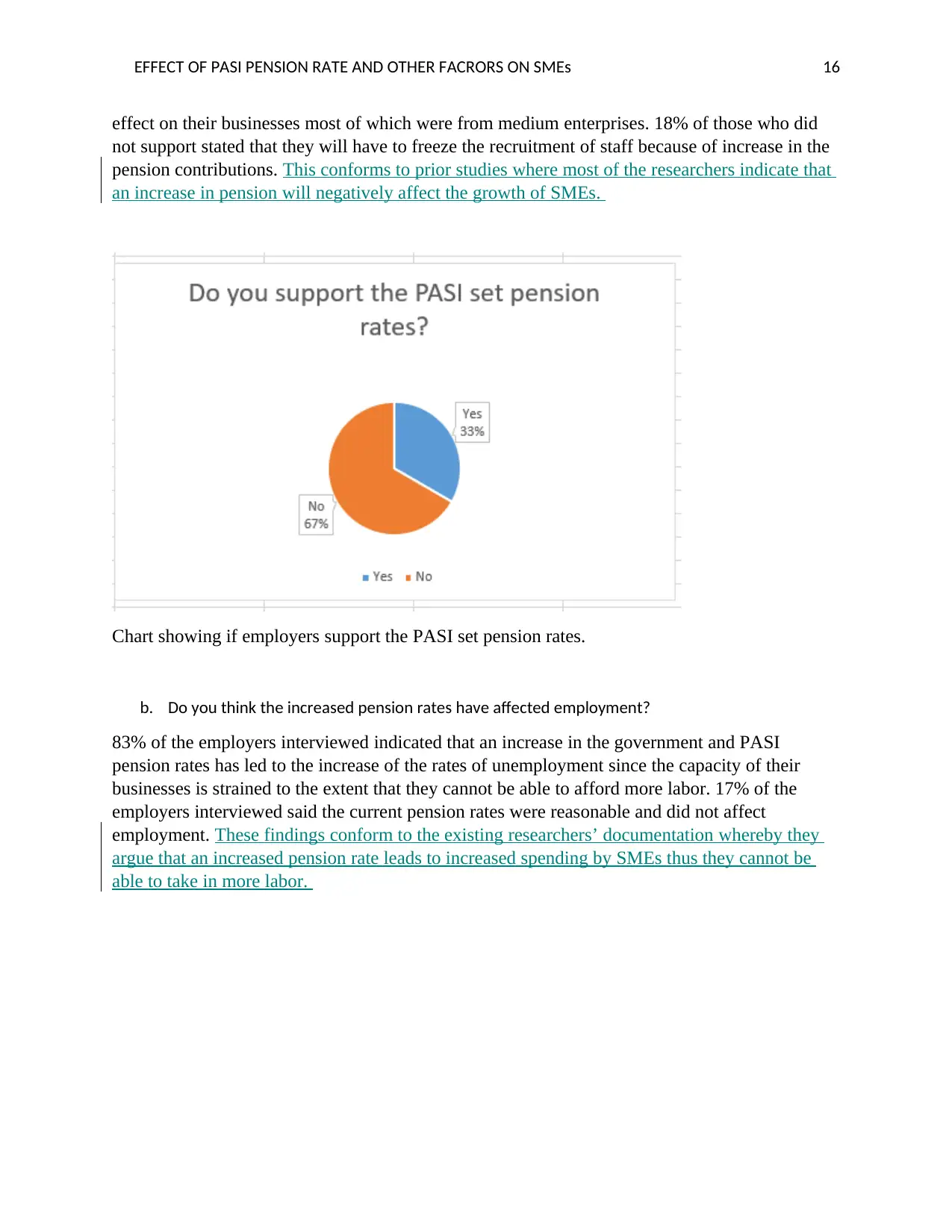
EFFECT OF PASI PENSION RATE AND OTHER FACRORS ON SMEs 16
effect on their businesses most of which were from medium enterprises. 18% of those who did
not support stated that they will have to freeze the recruitment of staff because of increase in the
pension contributions. This conforms to prior studies where most of the researchers indicate that
an increase in pension will negatively affect the growth of SMEs.
Chart showing if employers support the PASI set pension rates.
b. Do you think the increased pension rates have affected employment?
83% of the employers interviewed indicated that an increase in the government and PASI
pension rates has led to the increase of the rates of unemployment since the capacity of their
businesses is strained to the extent that they cannot be able to afford more labor. 17% of the
employers interviewed said the current pension rates were reasonable and did not affect
employment. These findings conform to the existing researchers’ documentation whereby they
argue that an increased pension rate leads to increased spending by SMEs thus they cannot be
able to take in more labor.
effect on their businesses most of which were from medium enterprises. 18% of those who did
not support stated that they will have to freeze the recruitment of staff because of increase in the
pension contributions. This conforms to prior studies where most of the researchers indicate that
an increase in pension will negatively affect the growth of SMEs.
Chart showing if employers support the PASI set pension rates.
b. Do you think the increased pension rates have affected employment?
83% of the employers interviewed indicated that an increase in the government and PASI
pension rates has led to the increase of the rates of unemployment since the capacity of their
businesses is strained to the extent that they cannot be able to afford more labor. 17% of the
employers interviewed said the current pension rates were reasonable and did not affect
employment. These findings conform to the existing researchers’ documentation whereby they
argue that an increased pension rate leads to increased spending by SMEs thus they cannot be
able to take in more labor.
Secure Best Marks with AI Grader
Need help grading? Try our AI Grader for instant feedback on your assignments.
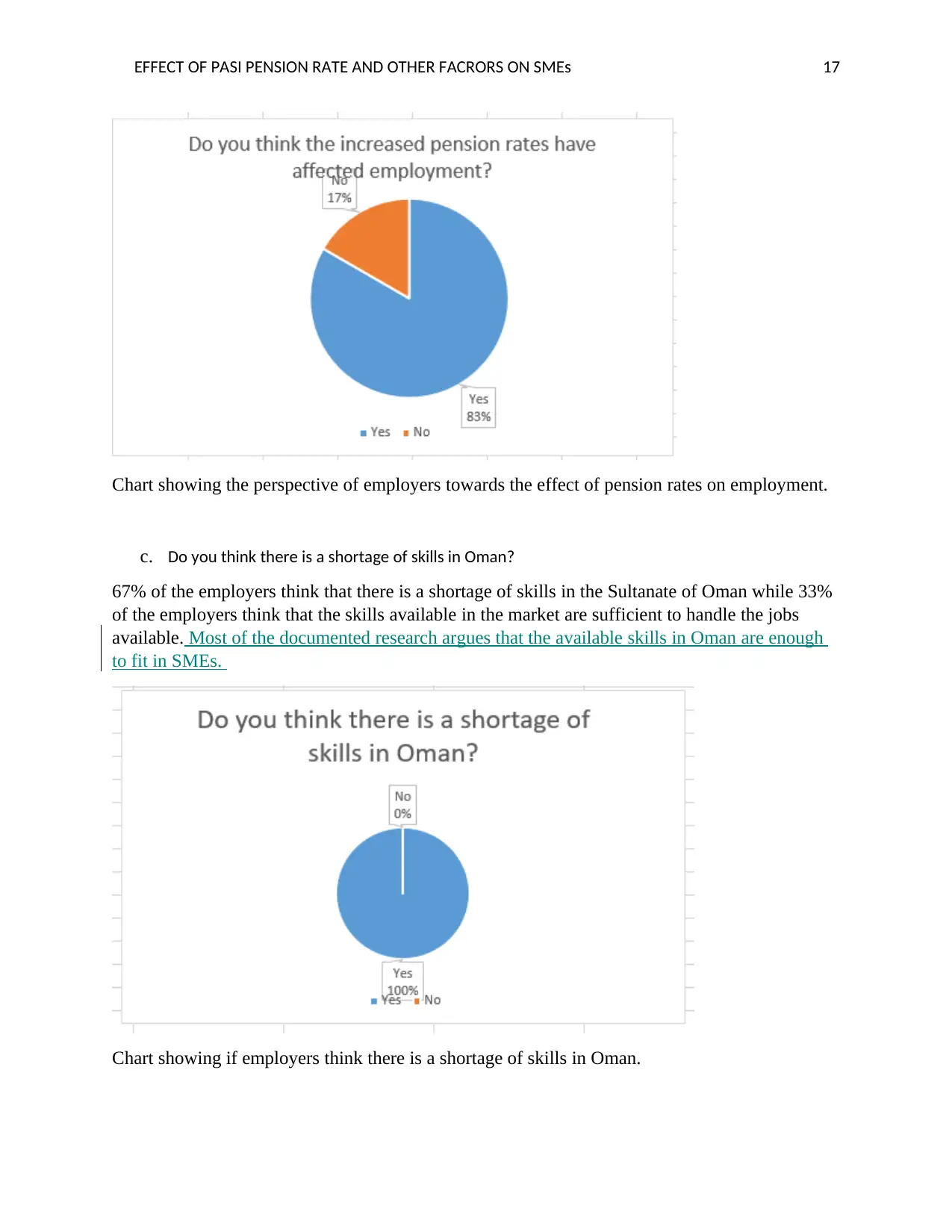
EFFECT OF PASI PENSION RATE AND OTHER FACRORS ON SMEs 17
Chart showing the perspective of employers towards the effect of pension rates on employment.
c. Do you think there is a shortage of skills in Oman?
67% of the employers think that there is a shortage of skills in the Sultanate of Oman while 33%
of the employers think that the skills available in the market are sufficient to handle the jobs
available. Most of the documented research argues that the available skills in Oman are enough
to fit in SMEs.
Chart showing if employers think there is a shortage of skills in Oman.
Chart showing the perspective of employers towards the effect of pension rates on employment.
c. Do you think there is a shortage of skills in Oman?
67% of the employers think that there is a shortage of skills in the Sultanate of Oman while 33%
of the employers think that the skills available in the market are sufficient to handle the jobs
available. Most of the documented research argues that the available skills in Oman are enough
to fit in SMEs.
Chart showing if employers think there is a shortage of skills in Oman.
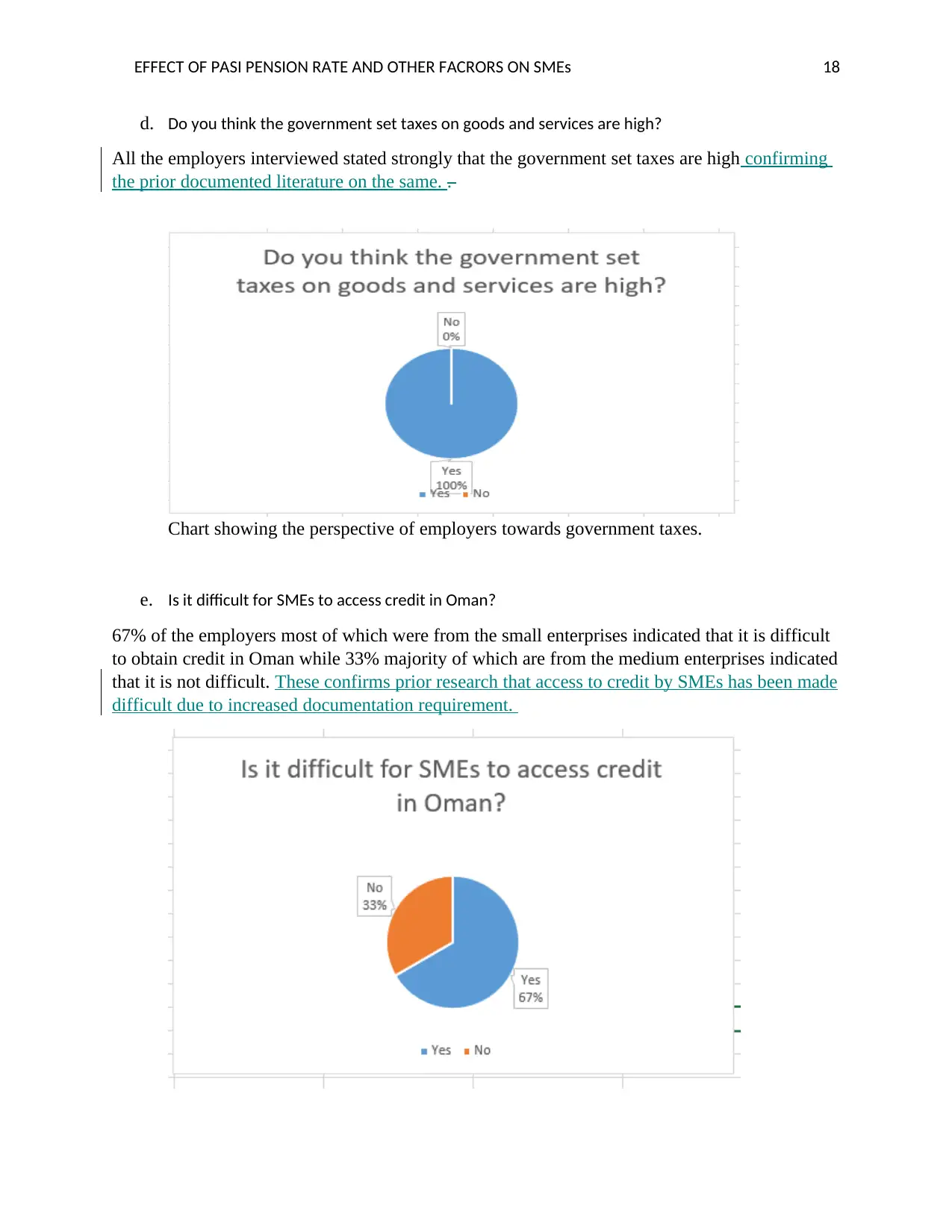
EFFECT OF PASI PENSION RATE AND OTHER FACRORS ON SMEs 18
d. Do you think the government set taxes on goods and services are high?
All the employers interviewed stated strongly that the government set taxes are high confirming
the prior documented literature on the same. .
Chart showing the perspective of employers towards government taxes.
e. Is it difficult for SMEs to access credit in Oman?
67% of the employers most of which were from the small enterprises indicated that it is difficult
to obtain credit in Oman while 33% majority of which are from the medium enterprises indicated
that it is not difficult. These confirms prior research that access to credit by SMEs has been made
difficult due to increased documentation requirement.
d. Do you think the government set taxes on goods and services are high?
All the employers interviewed stated strongly that the government set taxes are high confirming
the prior documented literature on the same. .
Chart showing the perspective of employers towards government taxes.
e. Is it difficult for SMEs to access credit in Oman?
67% of the employers most of which were from the small enterprises indicated that it is difficult
to obtain credit in Oman while 33% majority of which are from the medium enterprises indicated
that it is not difficult. These confirms prior research that access to credit by SMEs has been made
difficult due to increased documentation requirement.
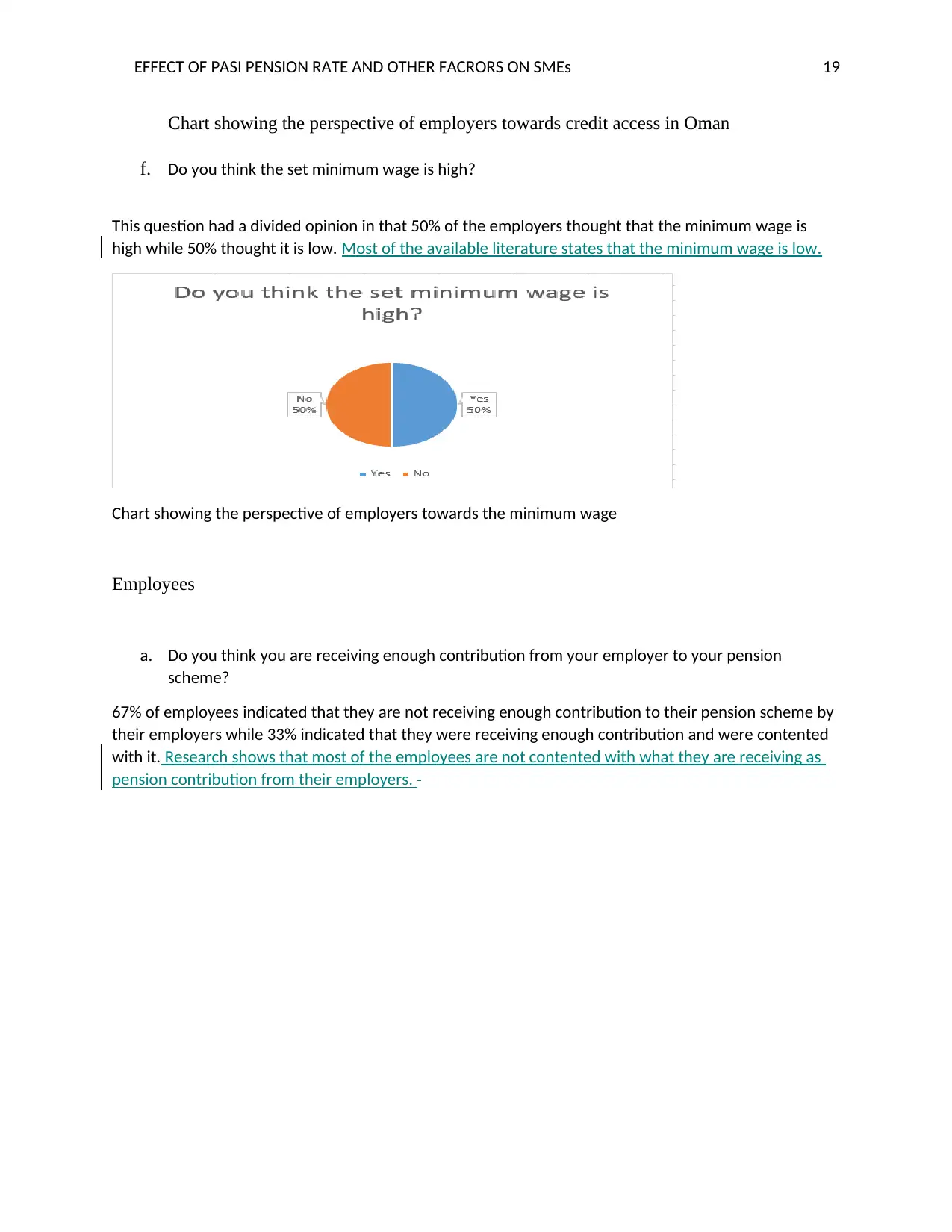
EFFECT OF PASI PENSION RATE AND OTHER FACRORS ON SMEs 19
Chart showing the perspective of employers towards credit access in Oman
f. Do you think the set minimum wage is high?
This question had a divided opinion in that 50% of the employers thought that the minimum wage is
high while 50% thought it is low. Most of the available literature states that the minimum wage is low.
Chart showing the perspective of employers towards the minimum wage
Employees
a. Do you think you are receiving enough contribution from your employer to your pension
scheme?
67% of employees indicated that they are not receiving enough contribution to their pension scheme by
their employers while 33% indicated that they were receiving enough contribution and were contented
with it. Research shows that most of the employees are not contented with what they are receiving as
pension contribution from their employers.
Chart showing the perspective of employers towards credit access in Oman
f. Do you think the set minimum wage is high?
This question had a divided opinion in that 50% of the employers thought that the minimum wage is
high while 50% thought it is low. Most of the available literature states that the minimum wage is low.
Chart showing the perspective of employers towards the minimum wage
Employees
a. Do you think you are receiving enough contribution from your employer to your pension
scheme?
67% of employees indicated that they are not receiving enough contribution to their pension scheme by
their employers while 33% indicated that they were receiving enough contribution and were contented
with it. Research shows that most of the employees are not contented with what they are receiving as
pension contribution from their employers.
Paraphrase This Document
Need a fresh take? Get an instant paraphrase of this document with our AI Paraphraser
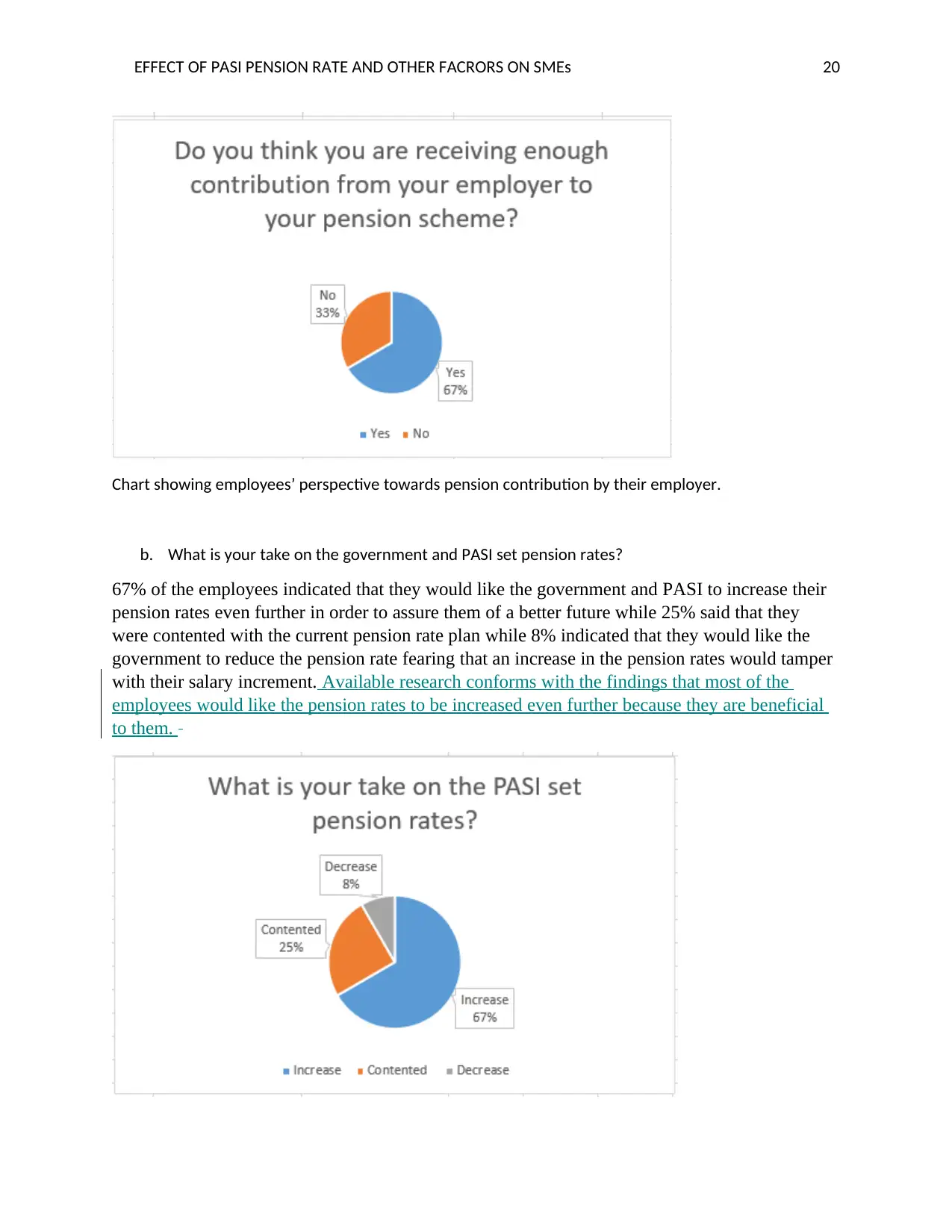
EFFECT OF PASI PENSION RATE AND OTHER FACRORS ON SMEs 20
Chart showing employees’ perspective towards pension contribution by their employer.
b. What is your take on the government and PASI set pension rates?
67% of the employees indicated that they would like the government and PASI to increase their
pension rates even further in order to assure them of a better future while 25% said that they
were contented with the current pension rate plan while 8% indicated that they would like the
government to reduce the pension rate fearing that an increase in the pension rates would tamper
with their salary increment. Available research conforms with the findings that most of the
employees would like the pension rates to be increased even further because they are beneficial
to them.
Chart showing employees’ perspective towards pension contribution by their employer.
b. What is your take on the government and PASI set pension rates?
67% of the employees indicated that they would like the government and PASI to increase their
pension rates even further in order to assure them of a better future while 25% said that they
were contented with the current pension rate plan while 8% indicated that they would like the
government to reduce the pension rate fearing that an increase in the pension rates would tamper
with their salary increment. Available research conforms with the findings that most of the
employees would like the pension rates to be increased even further because they are beneficial
to them.

EFFECT OF PASI PENSION RATE AND OTHER FACRORS ON SMEs 21
Chart showing the perspective of employees on pension rates.
c. Do you think the increased pension rates have affected employment?
33% of the employees interviewed agreed that increased pension rates have affected employment
in that their companies could not be able to take in more employees due to the high cost of labor.
67% of the employees interviewed maintained that despite the increase in the pension rates their
companies could still be able to employee more people due to the high profits they were making
conforming to available literature thus the pension rates increase were not affecting the capacity
of the SMEs to employ.
Chart shows the perspective of employees towards the effects of pension rate increase on
employment.
d. Do you think there is skill shortage in Oman?
42% of employees think that there is a shortage of skill in Oman contrary to available research
on the topic while 58% think that there is sufficient skill in Oman to handle the available jobs
and implement ideas in SMEs.
Chart showing the perspective of employees on pension rates.
c. Do you think the increased pension rates have affected employment?
33% of the employees interviewed agreed that increased pension rates have affected employment
in that their companies could not be able to take in more employees due to the high cost of labor.
67% of the employees interviewed maintained that despite the increase in the pension rates their
companies could still be able to employee more people due to the high profits they were making
conforming to available literature thus the pension rates increase were not affecting the capacity
of the SMEs to employ.
Chart shows the perspective of employees towards the effects of pension rate increase on
employment.
d. Do you think there is skill shortage in Oman?
42% of employees think that there is a shortage of skill in Oman contrary to available research
on the topic while 58% think that there is sufficient skill in Oman to handle the available jobs
and implement ideas in SMEs.
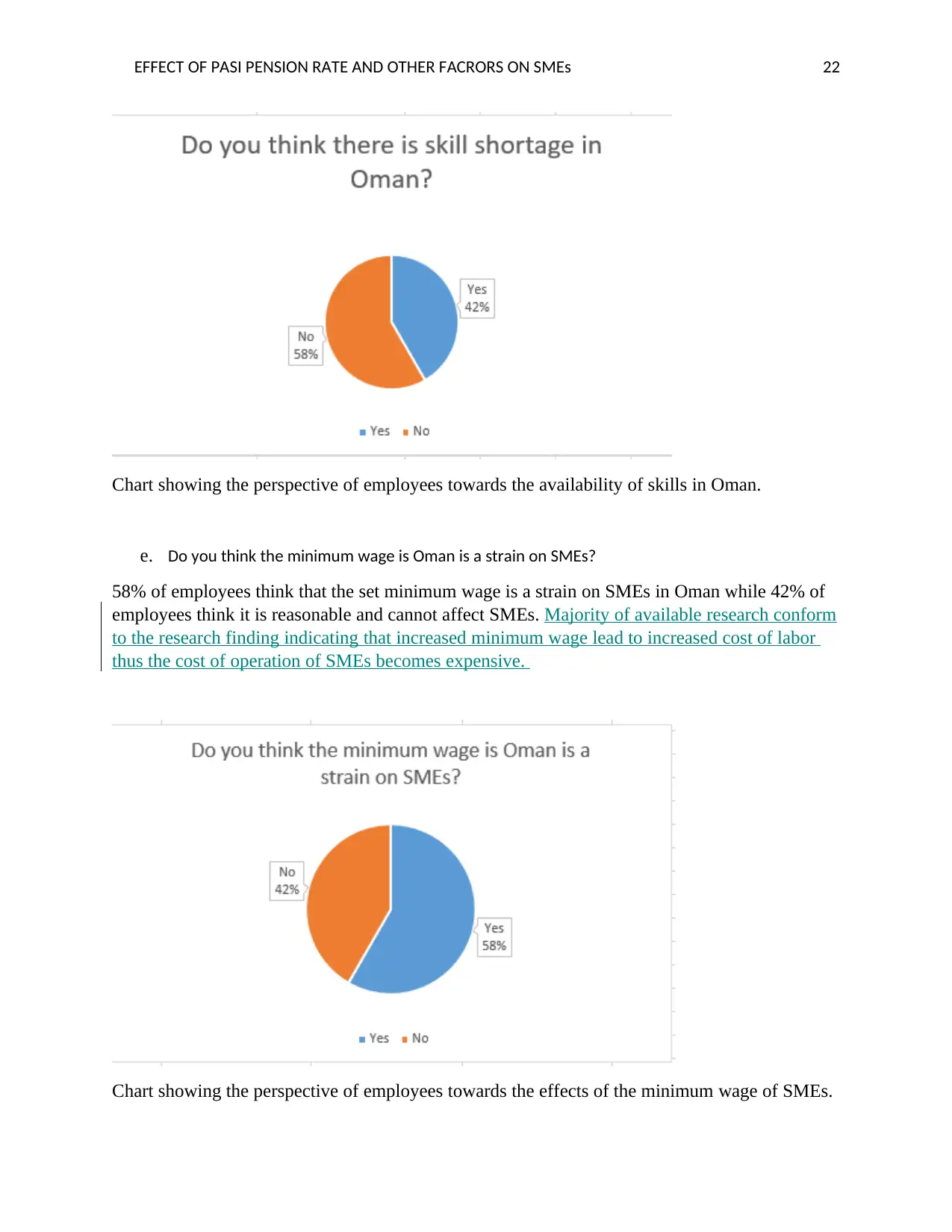
EFFECT OF PASI PENSION RATE AND OTHER FACRORS ON SMEs 22
Chart showing the perspective of employees towards the availability of skills in Oman.
e. Do you think the minimum wage is Oman is a strain on SMEs?
58% of employees think that the set minimum wage is a strain on SMEs in Oman while 42% of
employees think it is reasonable and cannot affect SMEs. Majority of available research conform
to the research finding indicating that increased minimum wage lead to increased cost of labor
thus the cost of operation of SMEs becomes expensive.
Chart showing the perspective of employees towards the effects of the minimum wage of SMEs.
Chart showing the perspective of employees towards the availability of skills in Oman.
e. Do you think the minimum wage is Oman is a strain on SMEs?
58% of employees think that the set minimum wage is a strain on SMEs in Oman while 42% of
employees think it is reasonable and cannot affect SMEs. Majority of available research conform
to the research finding indicating that increased minimum wage lead to increased cost of labor
thus the cost of operation of SMEs becomes expensive.
Chart showing the perspective of employees towards the effects of the minimum wage of SMEs.
Secure Best Marks with AI Grader
Need help grading? Try our AI Grader for instant feedback on your assignments.

EFFECT OF PASI PENSION RATE AND OTHER FACRORS ON SMEs 23
f. Do you think government taxes in Oman have a notable effect on the success of SMEs?
92% of the employees indicated that government set taxes have an effect on the growth of SMEs
while 8% stated that government taxes had no significant effect on the development of SMEs.
This conforms to existing research since they indicate that increased taxes increase the cost of
operation of SMEs thus slow down growth.
Chart showing the perspective of employees towards the set government taxes.
The data gathered from The Public Authority for Small & Medium Enterprises Development
(Riyada) and PACI funds shows the pension contribution of businesses over many years. In this
case emphasis was put on the past ten years. The data shows that in the past ten years the
required monthly contribution of businesses into the pension scheme of their employees has been
increasing gradually. The highest percentage of contribution by businesses to the pension scheme
can be noted in the past two years.
Chapter 5
ANALYSIS AND CONCLUSION
f. Do you think government taxes in Oman have a notable effect on the success of SMEs?
92% of the employees indicated that government set taxes have an effect on the growth of SMEs
while 8% stated that government taxes had no significant effect on the development of SMEs.
This conforms to existing research since they indicate that increased taxes increase the cost of
operation of SMEs thus slow down growth.
Chart showing the perspective of employees towards the set government taxes.
The data gathered from The Public Authority for Small & Medium Enterprises Development
(Riyada) and PACI funds shows the pension contribution of businesses over many years. In this
case emphasis was put on the past ten years. The data shows that in the past ten years the
required monthly contribution of businesses into the pension scheme of their employees has been
increasing gradually. The highest percentage of contribution by businesses to the pension scheme
can be noted in the past two years.
Chapter 5
ANALYSIS AND CONCLUSION
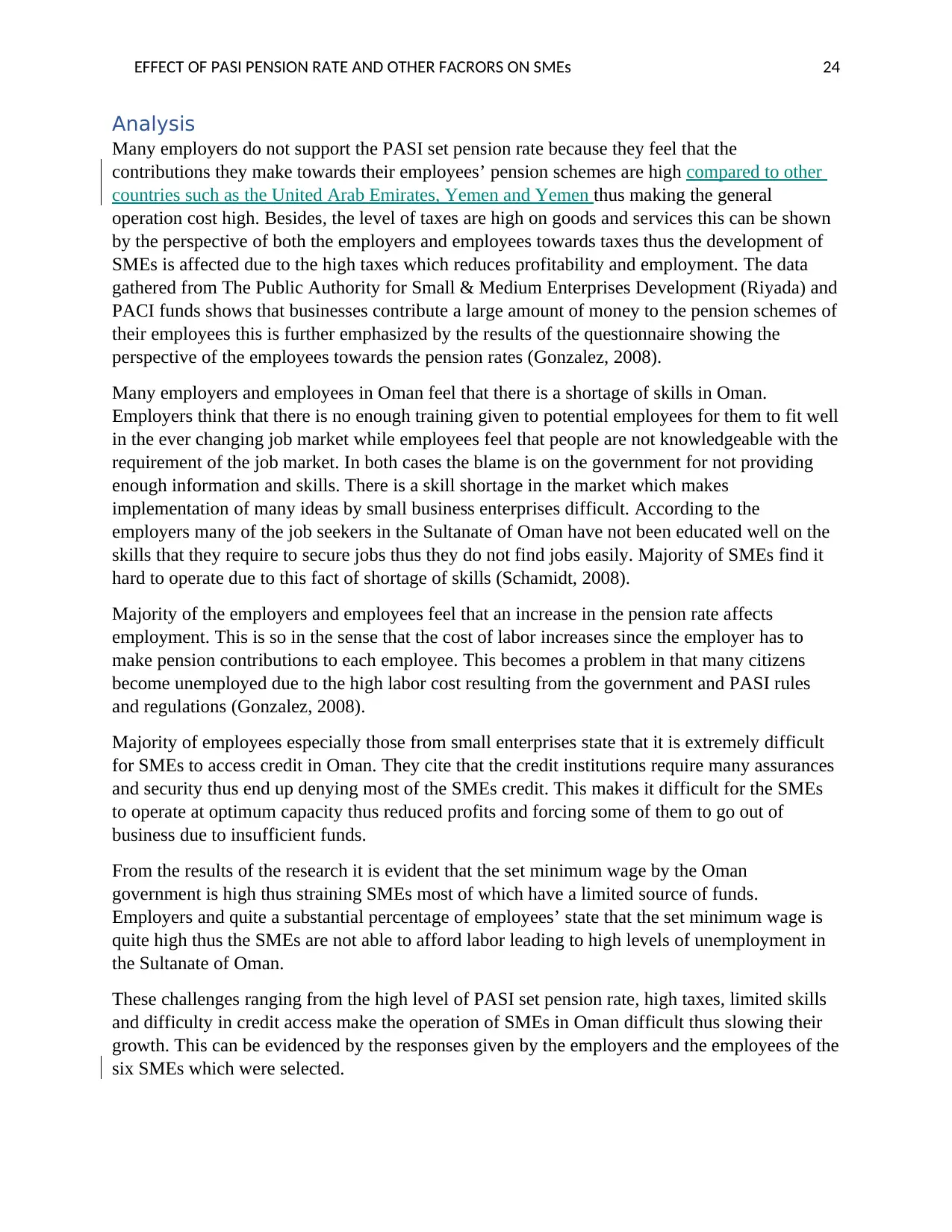
EFFECT OF PASI PENSION RATE AND OTHER FACRORS ON SMEs 24
Analysis
Many employers do not support the PASI set pension rate because they feel that the
contributions they make towards their employees’ pension schemes are high compared to other
countries such as the United Arab Emirates, Yemen and Yemen thus making the general
operation cost high. Besides, the level of taxes are high on goods and services this can be shown
by the perspective of both the employers and employees towards taxes thus the development of
SMEs is affected due to the high taxes which reduces profitability and employment. The data
gathered from The Public Authority for Small & Medium Enterprises Development (Riyada) and
PACI funds shows that businesses contribute a large amount of money to the pension schemes of
their employees this is further emphasized by the results of the questionnaire showing the
perspective of the employees towards the pension rates (Gonzalez, 2008).
Many employers and employees in Oman feel that there is a shortage of skills in Oman.
Employers think that there is no enough training given to potential employees for them to fit well
in the ever changing job market while employees feel that people are not knowledgeable with the
requirement of the job market. In both cases the blame is on the government for not providing
enough information and skills. There is a skill shortage in the market which makes
implementation of many ideas by small business enterprises difficult. According to the
employers many of the job seekers in the Sultanate of Oman have not been educated well on the
skills that they require to secure jobs thus they do not find jobs easily. Majority of SMEs find it
hard to operate due to this fact of shortage of skills (Schamidt, 2008).
Majority of the employers and employees feel that an increase in the pension rate affects
employment. This is so in the sense that the cost of labor increases since the employer has to
make pension contributions to each employee. This becomes a problem in that many citizens
become unemployed due to the high labor cost resulting from the government and PASI rules
and regulations (Gonzalez, 2008).
Majority of employees especially those from small enterprises state that it is extremely difficult
for SMEs to access credit in Oman. They cite that the credit institutions require many assurances
and security thus end up denying most of the SMEs credit. This makes it difficult for the SMEs
to operate at optimum capacity thus reduced profits and forcing some of them to go out of
business due to insufficient funds.
From the results of the research it is evident that the set minimum wage by the Oman
government is high thus straining SMEs most of which have a limited source of funds.
Employers and quite a substantial percentage of employees’ state that the set minimum wage is
quite high thus the SMEs are not able to afford labor leading to high levels of unemployment in
the Sultanate of Oman.
These challenges ranging from the high level of PASI set pension rate, high taxes, limited skills
and difficulty in credit access make the operation of SMEs in Oman difficult thus slowing their
growth. This can be evidenced by the responses given by the employers and the employees of the
six SMEs which were selected.
Analysis
Many employers do not support the PASI set pension rate because they feel that the
contributions they make towards their employees’ pension schemes are high compared to other
countries such as the United Arab Emirates, Yemen and Yemen thus making the general
operation cost high. Besides, the level of taxes are high on goods and services this can be shown
by the perspective of both the employers and employees towards taxes thus the development of
SMEs is affected due to the high taxes which reduces profitability and employment. The data
gathered from The Public Authority for Small & Medium Enterprises Development (Riyada) and
PACI funds shows that businesses contribute a large amount of money to the pension schemes of
their employees this is further emphasized by the results of the questionnaire showing the
perspective of the employees towards the pension rates (Gonzalez, 2008).
Many employers and employees in Oman feel that there is a shortage of skills in Oman.
Employers think that there is no enough training given to potential employees for them to fit well
in the ever changing job market while employees feel that people are not knowledgeable with the
requirement of the job market. In both cases the blame is on the government for not providing
enough information and skills. There is a skill shortage in the market which makes
implementation of many ideas by small business enterprises difficult. According to the
employers many of the job seekers in the Sultanate of Oman have not been educated well on the
skills that they require to secure jobs thus they do not find jobs easily. Majority of SMEs find it
hard to operate due to this fact of shortage of skills (Schamidt, 2008).
Majority of the employers and employees feel that an increase in the pension rate affects
employment. This is so in the sense that the cost of labor increases since the employer has to
make pension contributions to each employee. This becomes a problem in that many citizens
become unemployed due to the high labor cost resulting from the government and PASI rules
and regulations (Gonzalez, 2008).
Majority of employees especially those from small enterprises state that it is extremely difficult
for SMEs to access credit in Oman. They cite that the credit institutions require many assurances
and security thus end up denying most of the SMEs credit. This makes it difficult for the SMEs
to operate at optimum capacity thus reduced profits and forcing some of them to go out of
business due to insufficient funds.
From the results of the research it is evident that the set minimum wage by the Oman
government is high thus straining SMEs most of which have a limited source of funds.
Employers and quite a substantial percentage of employees’ state that the set minimum wage is
quite high thus the SMEs are not able to afford labor leading to high levels of unemployment in
the Sultanate of Oman.
These challenges ranging from the high level of PASI set pension rate, high taxes, limited skills
and difficulty in credit access make the operation of SMEs in Oman difficult thus slowing their
growth. This can be evidenced by the responses given by the employers and the employees of the
six SMEs which were selected.
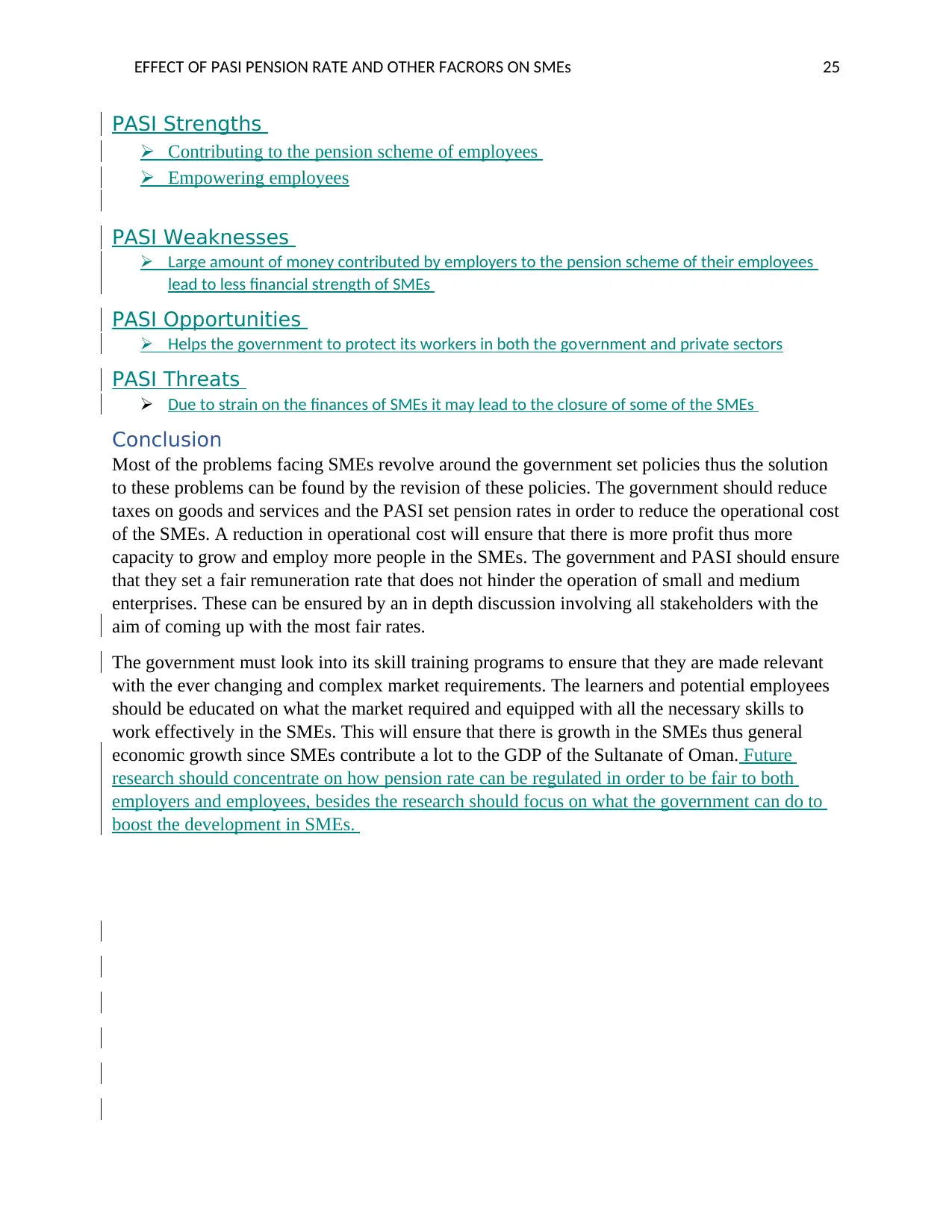
EFFECT OF PASI PENSION RATE AND OTHER FACRORS ON SMEs 25
PASI Strengths
Contributing to the pension scheme of employees
Empowering employees
PASI Weaknesses
Large amount of money contributed by employers to the pension scheme of their employees
lead to less financial strength of SMEs
PASI Opportunities
Helps the government to protect its workers in both the government and private sectors
PASI Threats
Due to strain on the finances of SMEs it may lead to the closure of some of the SMEs
Conclusion
Most of the problems facing SMEs revolve around the government set policies thus the solution
to these problems can be found by the revision of these policies. The government should reduce
taxes on goods and services and the PASI set pension rates in order to reduce the operational cost
of the SMEs. A reduction in operational cost will ensure that there is more profit thus more
capacity to grow and employ more people in the SMEs. The government and PASI should ensure
that they set a fair remuneration rate that does not hinder the operation of small and medium
enterprises. These can be ensured by an in depth discussion involving all stakeholders with the
aim of coming up with the most fair rates.
The government must look into its skill training programs to ensure that they are made relevant
with the ever changing and complex market requirements. The learners and potential employees
should be educated on what the market required and equipped with all the necessary skills to
work effectively in the SMEs. This will ensure that there is growth in the SMEs thus general
economic growth since SMEs contribute a lot to the GDP of the Sultanate of Oman. Future
research should concentrate on how pension rate can be regulated in order to be fair to both
employers and employees, besides the research should focus on what the government can do to
boost the development in SMEs.
PASI Strengths
Contributing to the pension scheme of employees
Empowering employees
PASI Weaknesses
Large amount of money contributed by employers to the pension scheme of their employees
lead to less financial strength of SMEs
PASI Opportunities
Helps the government to protect its workers in both the government and private sectors
PASI Threats
Due to strain on the finances of SMEs it may lead to the closure of some of the SMEs
Conclusion
Most of the problems facing SMEs revolve around the government set policies thus the solution
to these problems can be found by the revision of these policies. The government should reduce
taxes on goods and services and the PASI set pension rates in order to reduce the operational cost
of the SMEs. A reduction in operational cost will ensure that there is more profit thus more
capacity to grow and employ more people in the SMEs. The government and PASI should ensure
that they set a fair remuneration rate that does not hinder the operation of small and medium
enterprises. These can be ensured by an in depth discussion involving all stakeholders with the
aim of coming up with the most fair rates.
The government must look into its skill training programs to ensure that they are made relevant
with the ever changing and complex market requirements. The learners and potential employees
should be educated on what the market required and equipped with all the necessary skills to
work effectively in the SMEs. This will ensure that there is growth in the SMEs thus general
economic growth since SMEs contribute a lot to the GDP of the Sultanate of Oman. Future
research should concentrate on how pension rate can be regulated in order to be fair to both
employers and employees, besides the research should focus on what the government can do to
boost the development in SMEs.
Paraphrase This Document
Need a fresh take? Get an instant paraphrase of this document with our AI Paraphraser
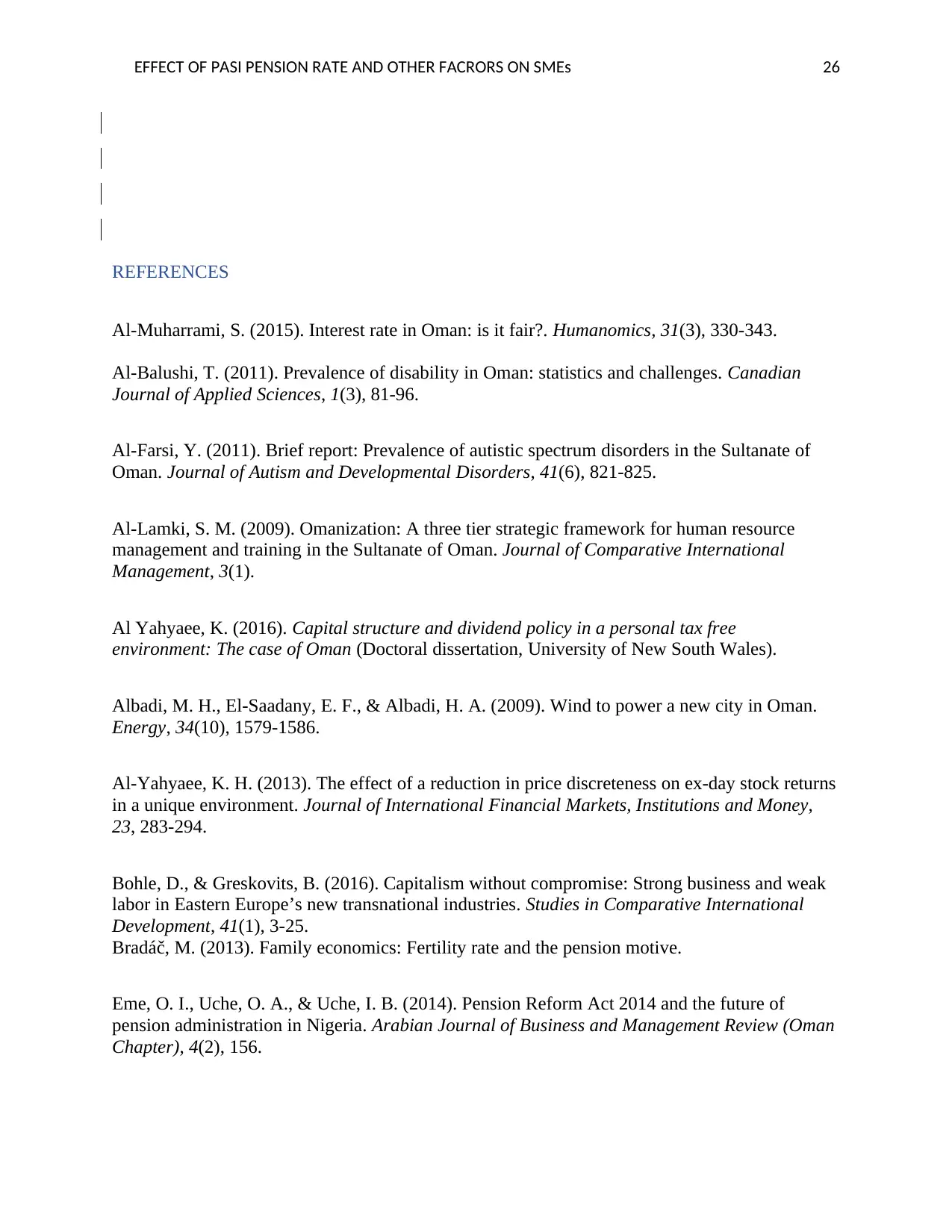
EFFECT OF PASI PENSION RATE AND OTHER FACRORS ON SMEs 26
REFERENCES
Al-Muharrami, S. (2015). Interest rate in Oman: is it fair?. Humanomics, 31(3), 330-343.
Al-Balushi, T. (2011). Prevalence of disability in Oman: statistics and challenges. Canadian
Journal of Applied Sciences, 1(3), 81-96.
Al-Farsi, Y. (2011). Brief report: Prevalence of autistic spectrum disorders in the Sultanate of
Oman. Journal of Autism and Developmental Disorders, 41(6), 821-825.
Al-Lamki, S. M. (2009). Omanization: A three tier strategic framework for human resource
management and training in the Sultanate of Oman. Journal of Comparative International
Management, 3(1).
Al Yahyaee, K. (2016). Capital structure and dividend policy in a personal tax free
environment: The case of Oman (Doctoral dissertation, University of New South Wales).
Albadi, M. H., El-Saadany, E. F., & Albadi, H. A. (2009). Wind to power a new city in Oman.
Energy, 34(10), 1579-1586.
Al-Yahyaee, K. H. (2013). The effect of a reduction in price discreteness on ex-day stock returns
in a unique environment. Journal of International Financial Markets, Institutions and Money,
23, 283-294.
Bohle, D., & Greskovits, B. (2016). Capitalism without compromise: Strong business and weak
labor in Eastern Europe’s new transnational industries. Studies in Comparative International
Development, 41(1), 3-25.
Bradáč, M. (2013). Family economics: Fertility rate and the pension motive.
Eme, O. I., Uche, O. A., & Uche, I. B. (2014). Pension Reform Act 2014 and the future of
pension administration in Nigeria. Arabian Journal of Business and Management Review (Oman
Chapter), 4(2), 156.
REFERENCES
Al-Muharrami, S. (2015). Interest rate in Oman: is it fair?. Humanomics, 31(3), 330-343.
Al-Balushi, T. (2011). Prevalence of disability in Oman: statistics and challenges. Canadian
Journal of Applied Sciences, 1(3), 81-96.
Al-Farsi, Y. (2011). Brief report: Prevalence of autistic spectrum disorders in the Sultanate of
Oman. Journal of Autism and Developmental Disorders, 41(6), 821-825.
Al-Lamki, S. M. (2009). Omanization: A three tier strategic framework for human resource
management and training in the Sultanate of Oman. Journal of Comparative International
Management, 3(1).
Al Yahyaee, K. (2016). Capital structure and dividend policy in a personal tax free
environment: The case of Oman (Doctoral dissertation, University of New South Wales).
Albadi, M. H., El-Saadany, E. F., & Albadi, H. A. (2009). Wind to power a new city in Oman.
Energy, 34(10), 1579-1586.
Al-Yahyaee, K. H. (2013). The effect of a reduction in price discreteness on ex-day stock returns
in a unique environment. Journal of International Financial Markets, Institutions and Money,
23, 283-294.
Bohle, D., & Greskovits, B. (2016). Capitalism without compromise: Strong business and weak
labor in Eastern Europe’s new transnational industries. Studies in Comparative International
Development, 41(1), 3-25.
Bradáč, M. (2013). Family economics: Fertility rate and the pension motive.
Eme, O. I., Uche, O. A., & Uche, I. B. (2014). Pension Reform Act 2014 and the future of
pension administration in Nigeria. Arabian Journal of Business and Management Review (Oman
Chapter), 4(2), 156.
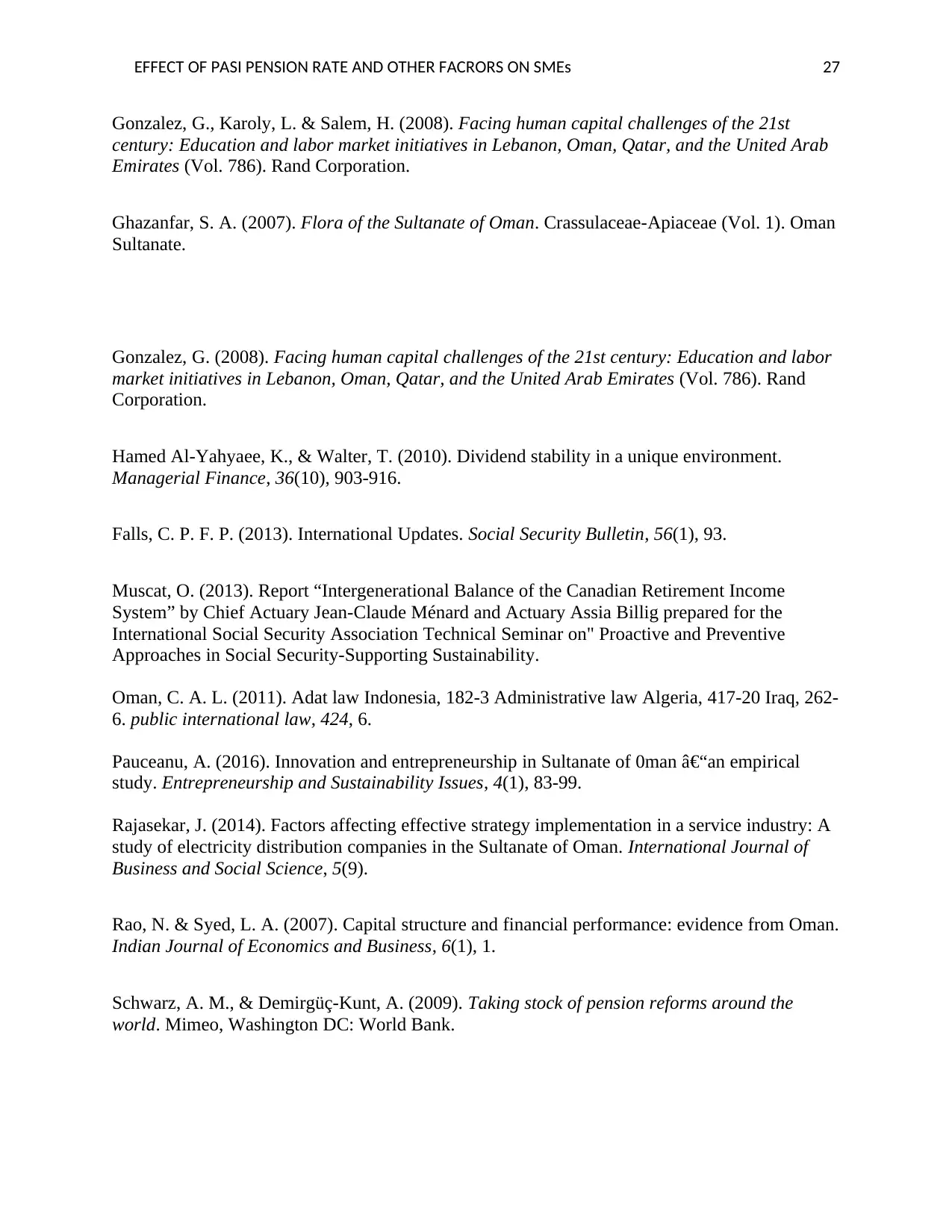
EFFECT OF PASI PENSION RATE AND OTHER FACRORS ON SMEs 27
Gonzalez, G., Karoly, L. & Salem, H. (2008). Facing human capital challenges of the 21st
century: Education and labor market initiatives in Lebanon, Oman, Qatar, and the United Arab
Emirates (Vol. 786). Rand Corporation.
Ghazanfar, S. A. (2007). Flora of the Sultanate of Oman. Crassulaceae-Apiaceae (Vol. 1). Oman
Sultanate.
Gonzalez, G. (2008). Facing human capital challenges of the 21st century: Education and labor
market initiatives in Lebanon, Oman, Qatar, and the United Arab Emirates (Vol. 786). Rand
Corporation.
Hamed Al-Yahyaee, K., & Walter, T. (2010). Dividend stability in a unique environment.
Managerial Finance, 36(10), 903-916.
Falls, C. P. F. P. (2013). International Updates. Social Security Bulletin, 56(1), 93.
Muscat, O. (2013). Report “Intergenerational Balance of the Canadian Retirement Income
System” by Chief Actuary Jean-Claude Ménard and Actuary Assia Billig prepared for the
International Social Security Association Technical Seminar on" Proactive and Preventive
Approaches in Social Security-Supporting Sustainability.
Oman, C. A. L. (2011). Adat law Indonesia, 182-3 Administrative law Algeria, 417-20 Iraq, 262-
6. public international law, 424, 6.
Pauceanu, A. (2016). Innovation and entrepreneurship in Sultanate of 0man –an empirical
study. Entrepreneurship and Sustainability Issues, 4(1), 83-99.
Rajasekar, J. (2014). Factors affecting effective strategy implementation in a service industry: A
study of electricity distribution companies in the Sultanate of Oman. International Journal of
Business and Social Science, 5(9).
Rao, N. & Syed, L. A. (2007). Capital structure and financial performance: evidence from Oman.
Indian Journal of Economics and Business, 6(1), 1.
Schwarz, A. M., & Demirgüç-Kunt, A. (2009). Taking stock of pension reforms around the
world. Mimeo, Washington DC: World Bank.
Gonzalez, G., Karoly, L. & Salem, H. (2008). Facing human capital challenges of the 21st
century: Education and labor market initiatives in Lebanon, Oman, Qatar, and the United Arab
Emirates (Vol. 786). Rand Corporation.
Ghazanfar, S. A. (2007). Flora of the Sultanate of Oman. Crassulaceae-Apiaceae (Vol. 1). Oman
Sultanate.
Gonzalez, G. (2008). Facing human capital challenges of the 21st century: Education and labor
market initiatives in Lebanon, Oman, Qatar, and the United Arab Emirates (Vol. 786). Rand
Corporation.
Hamed Al-Yahyaee, K., & Walter, T. (2010). Dividend stability in a unique environment.
Managerial Finance, 36(10), 903-916.
Falls, C. P. F. P. (2013). International Updates. Social Security Bulletin, 56(1), 93.
Muscat, O. (2013). Report “Intergenerational Balance of the Canadian Retirement Income
System” by Chief Actuary Jean-Claude Ménard and Actuary Assia Billig prepared for the
International Social Security Association Technical Seminar on" Proactive and Preventive
Approaches in Social Security-Supporting Sustainability.
Oman, C. A. L. (2011). Adat law Indonesia, 182-3 Administrative law Algeria, 417-20 Iraq, 262-
6. public international law, 424, 6.
Pauceanu, A. (2016). Innovation and entrepreneurship in Sultanate of 0man –an empirical
study. Entrepreneurship and Sustainability Issues, 4(1), 83-99.
Rajasekar, J. (2014). Factors affecting effective strategy implementation in a service industry: A
study of electricity distribution companies in the Sultanate of Oman. International Journal of
Business and Social Science, 5(9).
Rao, N. & Syed, L. A. (2007). Capital structure and financial performance: evidence from Oman.
Indian Journal of Economics and Business, 6(1), 1.
Schwarz, A. M., & Demirgüç-Kunt, A. (2009). Taking stock of pension reforms around the
world. Mimeo, Washington DC: World Bank.
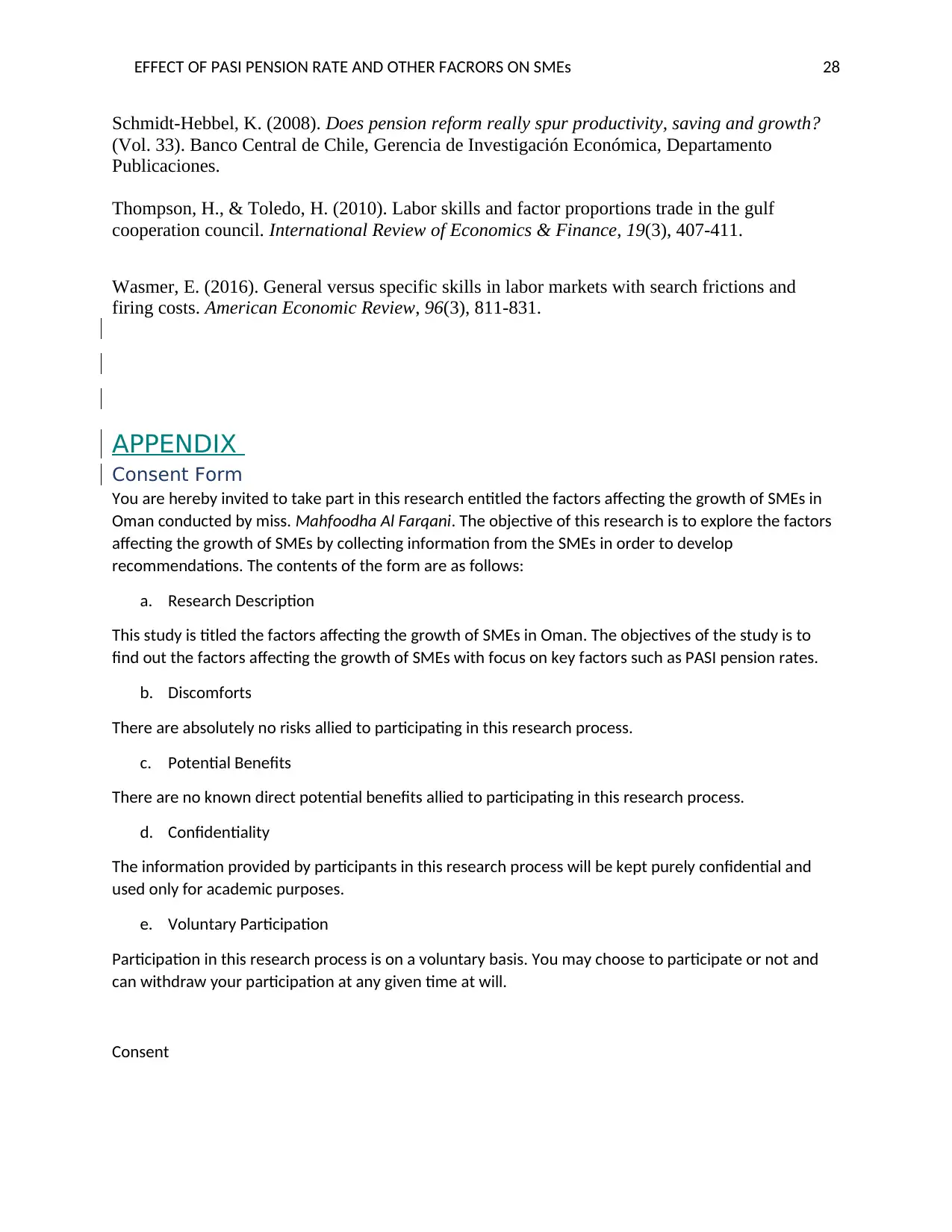
EFFECT OF PASI PENSION RATE AND OTHER FACRORS ON SMEs 28
Schmidt-Hebbel, K. (2008). Does pension reform really spur productivity, saving and growth?
(Vol. 33). Banco Central de Chile, Gerencia de Investigación Económica, Departamento
Publicaciones.
Thompson, H., & Toledo, H. (2010). Labor skills and factor proportions trade in the gulf
cooperation council. International Review of Economics & Finance, 19(3), 407-411.
Wasmer, E. (2016). General versus specific skills in labor markets with search frictions and
firing costs. American Economic Review, 96(3), 811-831.
APPENDIX
Consent Form
You are hereby invited to take part in this research entitled the factors affecting the growth of SMEs in
Oman conducted by miss. Mahfoodha Al Farqani. The objective of this research is to explore the factors
affecting the growth of SMEs by collecting information from the SMEs in order to develop
recommendations. The contents of the form are as follows:
a. Research Description
This study is titled the factors affecting the growth of SMEs in Oman. The objectives of the study is to
find out the factors affecting the growth of SMEs with focus on key factors such as PASI pension rates.
b. Discomforts
There are absolutely no risks allied to participating in this research process.
c. Potential Benefits
There are no known direct potential benefits allied to participating in this research process.
d. Confidentiality
The information provided by participants in this research process will be kept purely confidential and
used only for academic purposes.
e. Voluntary Participation
Participation in this research process is on a voluntary basis. You may choose to participate or not and
can withdraw your participation at any given time at will.
Consent
Schmidt-Hebbel, K. (2008). Does pension reform really spur productivity, saving and growth?
(Vol. 33). Banco Central de Chile, Gerencia de Investigación Económica, Departamento
Publicaciones.
Thompson, H., & Toledo, H. (2010). Labor skills and factor proportions trade in the gulf
cooperation council. International Review of Economics & Finance, 19(3), 407-411.
Wasmer, E. (2016). General versus specific skills in labor markets with search frictions and
firing costs. American Economic Review, 96(3), 811-831.
APPENDIX
Consent Form
You are hereby invited to take part in this research entitled the factors affecting the growth of SMEs in
Oman conducted by miss. Mahfoodha Al Farqani. The objective of this research is to explore the factors
affecting the growth of SMEs by collecting information from the SMEs in order to develop
recommendations. The contents of the form are as follows:
a. Research Description
This study is titled the factors affecting the growth of SMEs in Oman. The objectives of the study is to
find out the factors affecting the growth of SMEs with focus on key factors such as PASI pension rates.
b. Discomforts
There are absolutely no risks allied to participating in this research process.
c. Potential Benefits
There are no known direct potential benefits allied to participating in this research process.
d. Confidentiality
The information provided by participants in this research process will be kept purely confidential and
used only for academic purposes.
e. Voluntary Participation
Participation in this research process is on a voluntary basis. You may choose to participate or not and
can withdraw your participation at any given time at will.
Consent
Secure Best Marks with AI Grader
Need help grading? Try our AI Grader for instant feedback on your assignments.
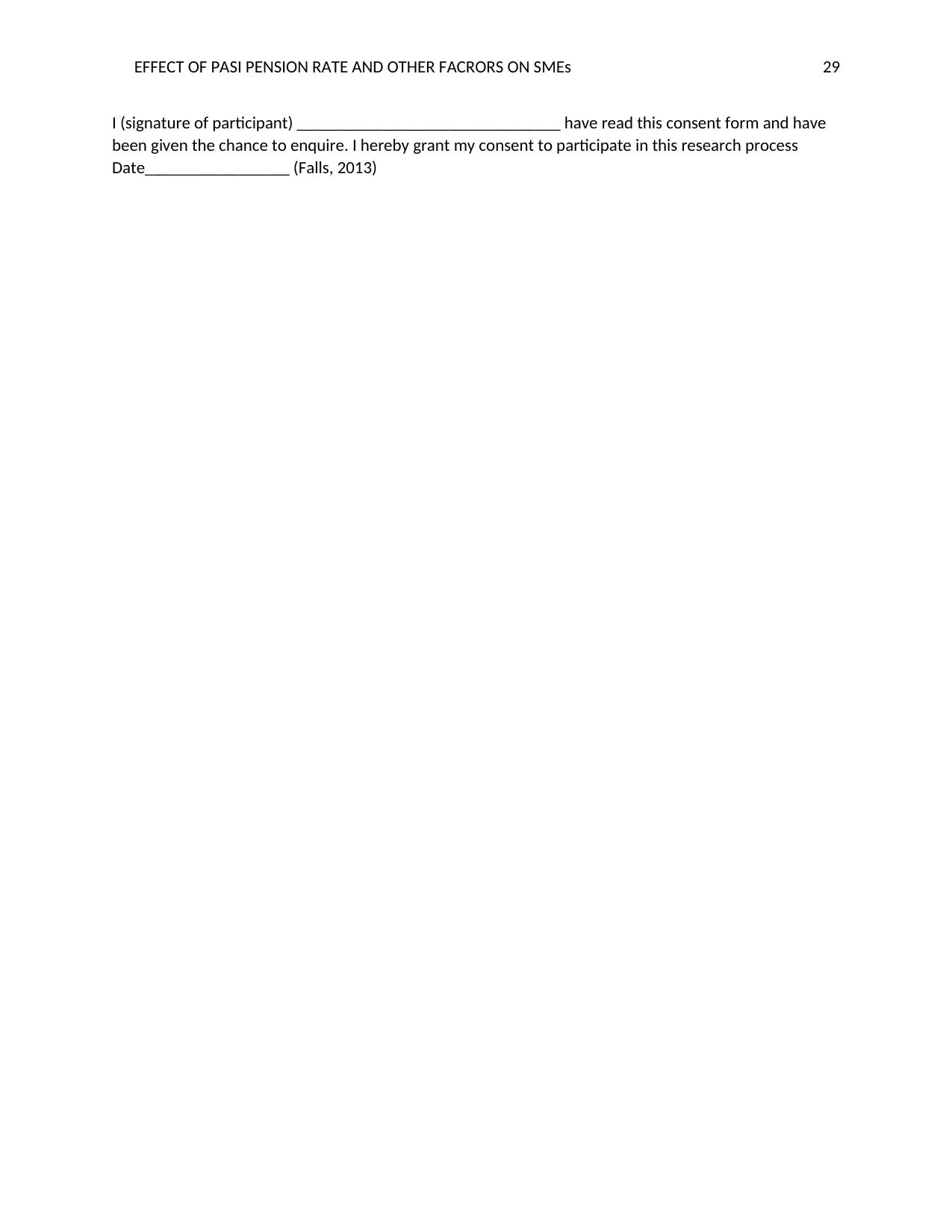
EFFECT OF PASI PENSION RATE AND OTHER FACRORS ON SMEs 29
I (signature of participant) _______________________________ have read this consent form and have
been given the chance to enquire. I hereby grant my consent to participate in this research process
Date_________________ (Falls, 2013)
I (signature of participant) _______________________________ have read this consent form and have
been given the chance to enquire. I hereby grant my consent to participate in this research process
Date_________________ (Falls, 2013)
1 out of 29
Related Documents
Your All-in-One AI-Powered Toolkit for Academic Success.
+13062052269
info@desklib.com
Available 24*7 on WhatsApp / Email
![[object Object]](/_next/static/media/star-bottom.7253800d.svg)
Unlock your academic potential
© 2024 | Zucol Services PVT LTD | All rights reserved.




